- OEM
- Plan & Prepare for Emergencies
- Educate the Public
- Coordinate Response & Recovery
- Collect & Disseminate Information
- Hurricane Irene
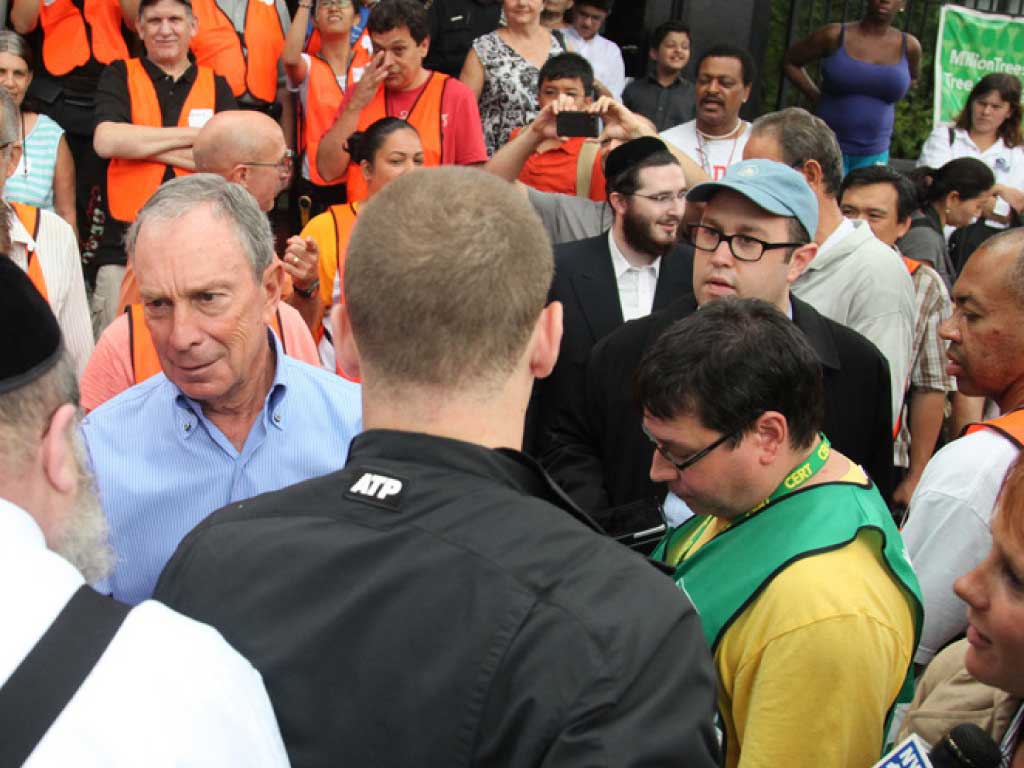
Message from the Mayor
Message from the Mayor
Every day New York City is incredibly busy and full of unexpected occurrences — some of them minor and short-lived and some more significant and longer lasting. From local water main breaks and power outages to broader emergencies, including tornadoes, blizzards, and last year a hurricane and an earthquake in the same week, the New York City Office of Emergency Management (OEM) is working to plan for, respond to and recover from these events. While OEM is a relatively small agency with less than 200 staff members, it works closely with City, state, federal, non-profit and private sector and regional agencies to ensure New York City is as prepared as possible. OEM is also fortunate to have many volunteers, including OEM-sponsored Community Emergency Response Teams (CERT), that help it achieve its mission.
When Hurricane Irene appeared on forecasts as a storm that might impact New York City, OEM's extensive planning and preparation over the past several years were put to the test.
Commissioner Bruno and his staff implemented the City's Coastal Storm Plan, activated the City's Emergency Operations Center, pre-positioned available supplies, and coordinated the actions of many government and non-government agencies to ensure that New York City was ready for whatever Irene brought us. After the storm had passed, OEM began examining the City's response to this incident and adjusting the Coastal Storm Plan based on lessons learned.
This biennial report looks at OEM's work before, during, and after Hurricane Irene, as well as many other emergencies the city faced in 2010 and 2011. Having the dedicated men and women of OEM working 24 hours a day, 7 days a week greatly increases our city's resiliency. OEM also collaborates closely with our partners in other parts of New York, as well as New Jersey and Connecticut, because, as we know, emergencies, particularly storms and natural disasters, know no boundaries. This report will show ways that emergency preparedness has improved in New York City over the past two years.
Michael R. Bloomberg
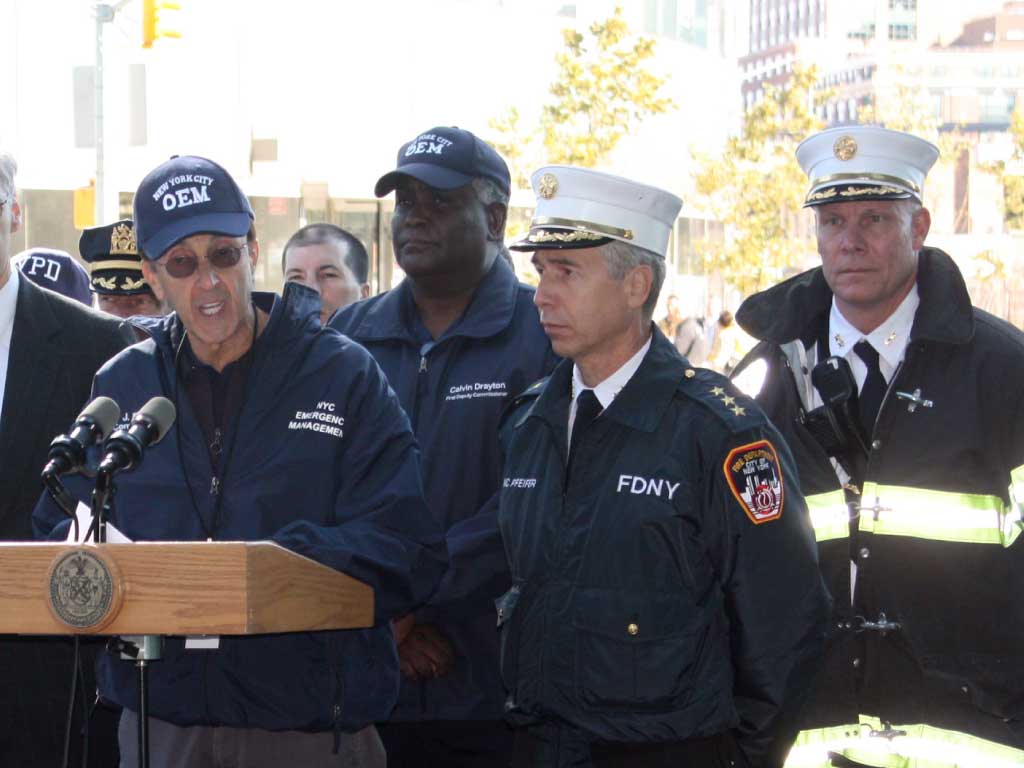
Commissioner's Message
Commissioner's Message
I am pleased to present the OEM 2010/2011 Biennial Report. This report outlines OEM's major work over the past two years, including planning for and responding to severe weather, power outages, water main breaks, and other incidents, as well educating the public on how to prepare for emergencies and supplying vital information to our partner agencies.
This report is a departure in format from previous biennial reports. It is 100% digital. This new format allows us to display information more effectively and reduce cost and waste by saving paper and printing costs. The easy display and indexing features allow people to find the areas of our work which most directly interest them.
I continue to be extremely proud of the accomplishments of OEM and its people. Our multi-disciplinary workforce includes planners, architects, communications experts, "techies" of all sorts, firefighters and law enforcement professionals, and just plain smart folks.
Whether it is a surprise winter storm at Halloween or a prolonged heat wave in the middle of the summer, OEM is prepared to work until the danger has passed to make sure the city emerges stronger than ever and our residents are safe and secure.
As this report illustrates, our staff remains committed to ensuring that New York City is on the cutting edge of emergency management and is the most prepared city in the nation and across the globe.
Joseph F. Bruno
Commissioner
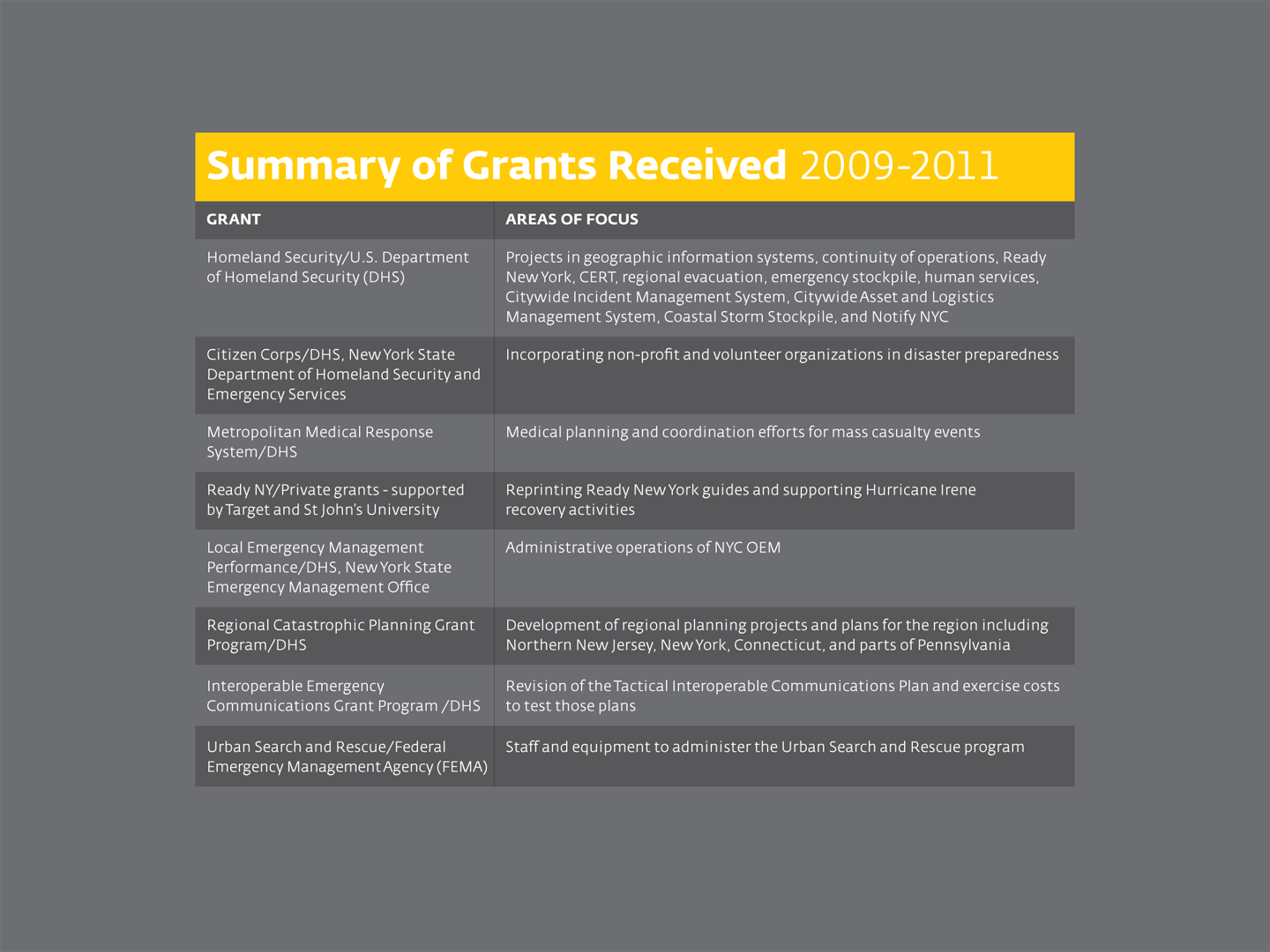
Funding

Plan and
Prepare for
Emergencies
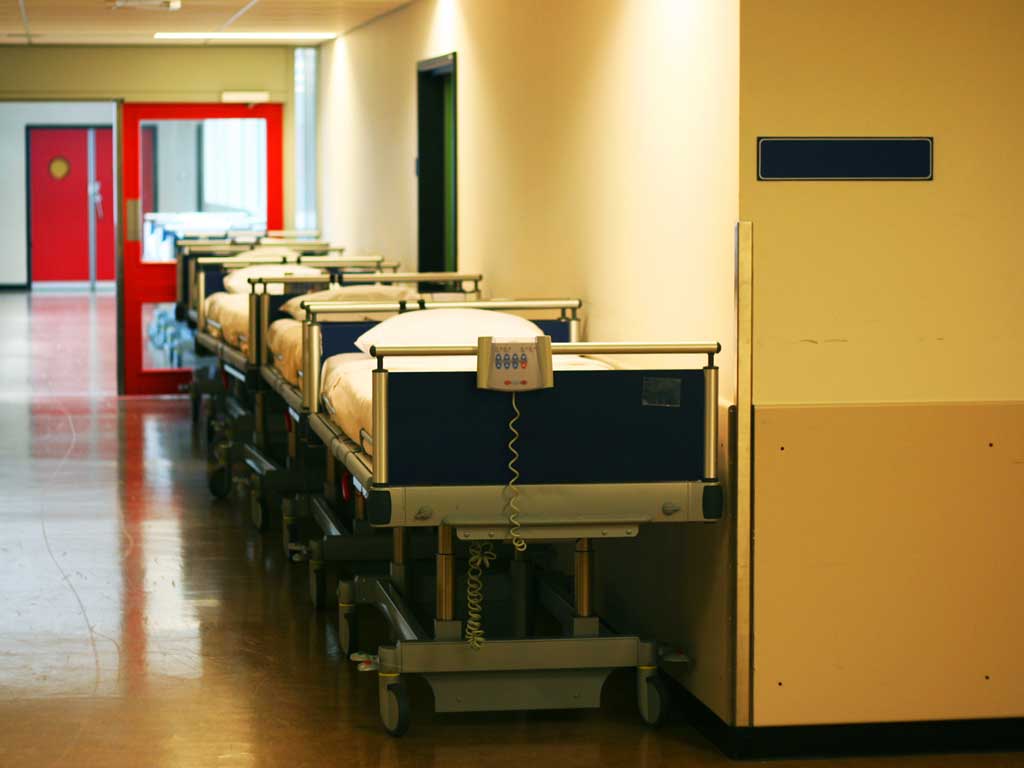
New Plans: Burn Surge Response Protocol
In an emergency with a large number of burn patients, specialized resources needed to care for these patients may become overwhelmed. To increase hospitals' abilities to manage large numbers of burn injuries, the Burn Surge Response Protocol creates a network of hospitals equipped to provide stabilizing burn care until primary burn beds become available. The protocol, released in February 2011, is the product of an interagency working group composed of OEM, Fire Department, City and State Health Departments, Health and Hospitals Corporation, and Greater New York Hospital Association. Based on this protocol, New York City now has seven times the number of hospitals capable of providing stabilizing burn care than it did previously.
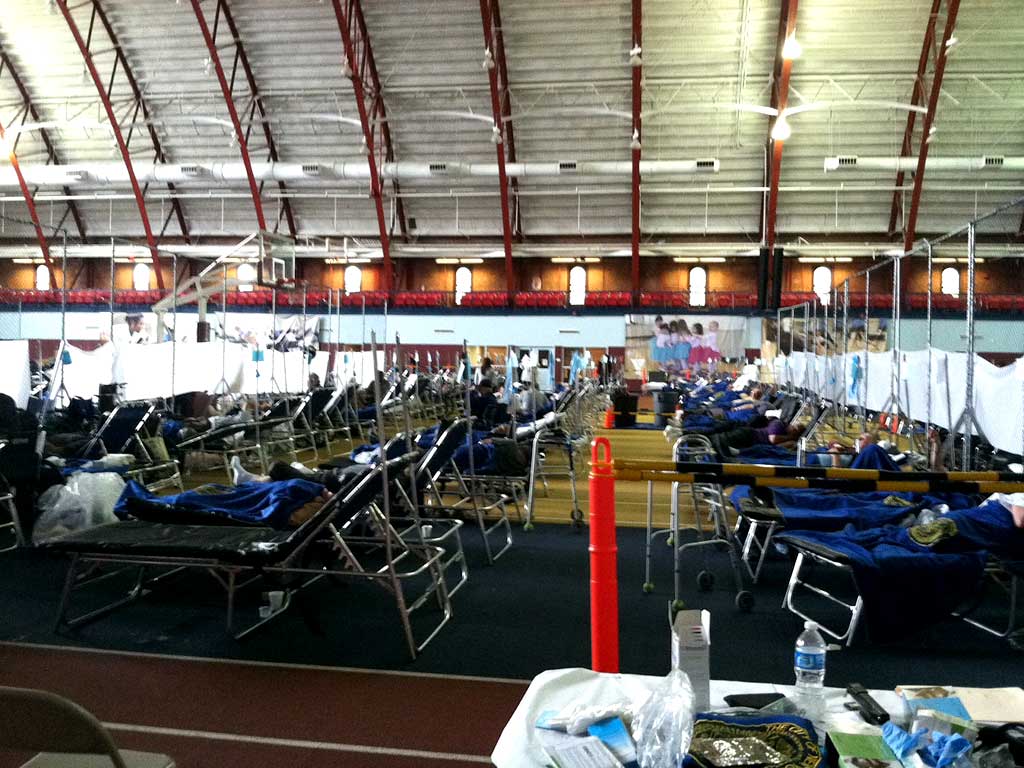
New Plans: Special Medical Needs Shelter Field Guides
In the event of a hurricane, the New York City Coastal Storm Plan calls for the City to open up to eight special medical needs shelters (SMNS) — temporary emergency facilities for evacuees who need special medical care. OEM, with the Health Department, Homeless Services Department, and the Health and Hospitals Corporation, developed the SMNS Field Guide as a tool to help staff manage these facilities. The guide includes instructions and practical information to support SMNS operations before, during, and after a coastal storm. These guides became a critical resource for protecting many nursing home residents who were housed in special medical needs shelters during Hurricane Irene.
Special Medical Needs Shelter Field Guides
The gymnasium at the Park Slope Armory in Brooklyn served as a special medical needs shelter during Hurricane Irene in August 2011. The Special Medical Needs Shelter Field Guide helped shelter staff set up the facility and helped medical staff run the shelter.

New Plans: Repatriation Protocol
In response to the possibility that U.S. citizens would be repatriated from countries and regions affected by disasters and unrest – including Haiti, the Middle East, and Japan – with New York City as their point of entry, OEM convened a multi-agency working group to develop the Repatriation Protocol. Completed in March 2011, the Repatriation Protocol describes how the City would work with federal, state, and nongovernmental agencies to provide temporary services, such as shelter, food, and transportation, to repatriated American citizens arriving home through New York City.
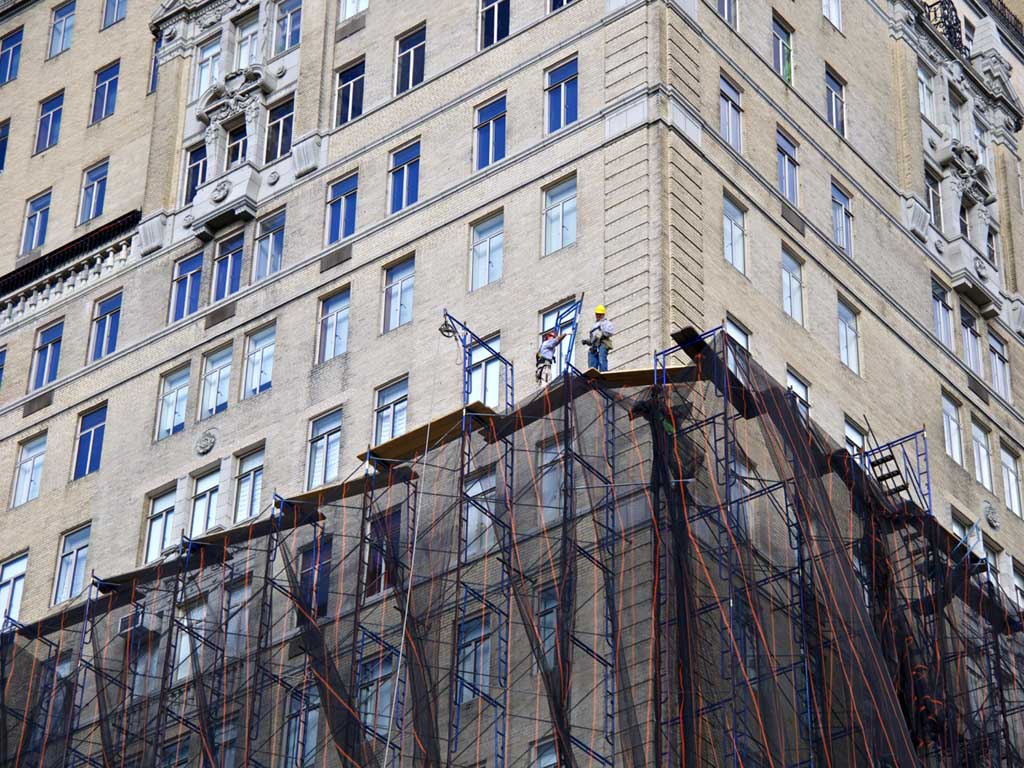
New Plans: Damage Assessment Power Restoration Protocol
In 2010, OEM developed the Damage Assessment Power Restoration (DAPR) Protocol in collaboration with the Department of Buildings, Department of Environmental Protection, Con Edison, National Grid, and Long Island Power Authority. The DAPR Protocol outlines how the Department of Buildings will coordinate structural stability assessments with utility providers so that all agencies working to repair infrastructure are operating safely and efficiently. Following a severe weather event like a hurricane or a powerful tornado that causes significant damage to buildings, the DAPR Protocol can be used to more safely and effectively coordinate building and utility repairs.

New Plans: Oil Spill Response Protocol
After the BP Deepwater Horizon drilling platform sank off the Louisiana coast in April 2010, OEM worked with NYC agencies to develop a contingency protocol that identifies roles and responsibilities for responding to oil contamination on city shores and waterways. Focusing largely on the City's Health and Environmental Protection Departments' monitoring capabilities, the protocol addresses how the City would close beaches and waterways, disseminate public messaging, and coordinate City, state, and federal agencies in an oil spill response.
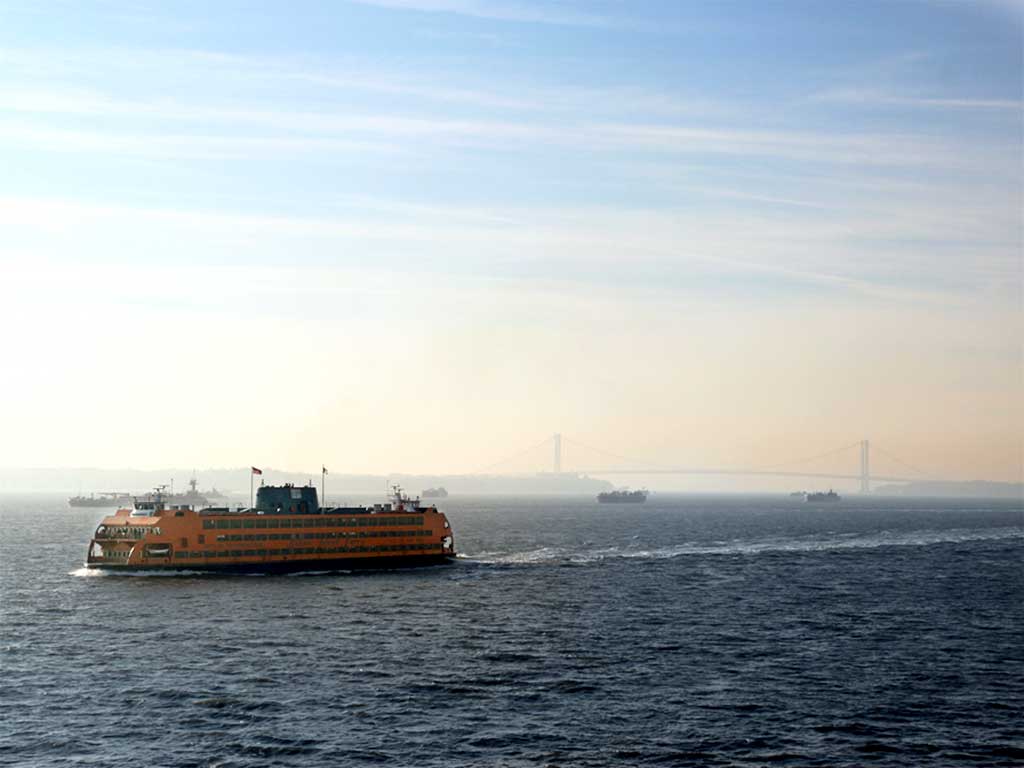
New Plans: Maritime Emergency Transportation Plan
The Maritime Emergency Transportation Plan (METP) coordinates the use of maritime assets, including private and City-owned ferries, to support marine-based evacuations. The plan also coordinates mass transit and pedestrian traffic to increase access to ferry landings in the New York/New Jersey harbor, including New Jersey State’s Liberty Park and the World Financial Center. In addition, the METP links with regional plans for adjacent jurisdictions, including New Jersey’s Trans-Hudson Emergency Transportation Plan and the U.S. Coast Guard’s Concept of Operations for Maritime Evacuations.
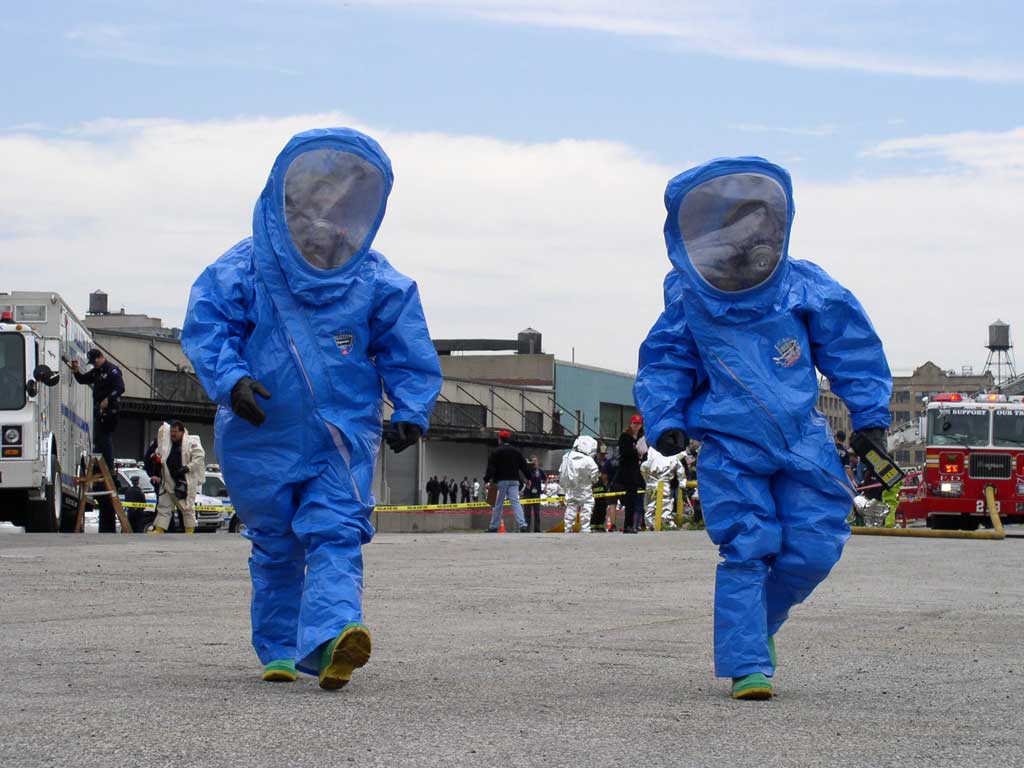
New Plans: Radiological Response and Recovery Plan
Radiological hazards resulting from the accidental or deliberate release of radioactive material can cause immediate casualties, affect the economy, and potentially contaminate areas of the city for years. OEM, along with the Environmental Protection, Fire, Health, and Police Departments, developed the Radiological Response and Recovery Plan to guide agency actions following the detection of such a release. The plan outlines strategies for first responders, public health and environmental experts, and agency decision-makers to manage a radiological incident from the initial minutes after detection to weeks into the recovery period. The plan reflects observations from the earthquake and tsunami that sparked triple meltdowns at Japan’s Fukushima nuclear power plant on March 11, 2011, the largest nuclear disaster since Chernobyl in 1986.
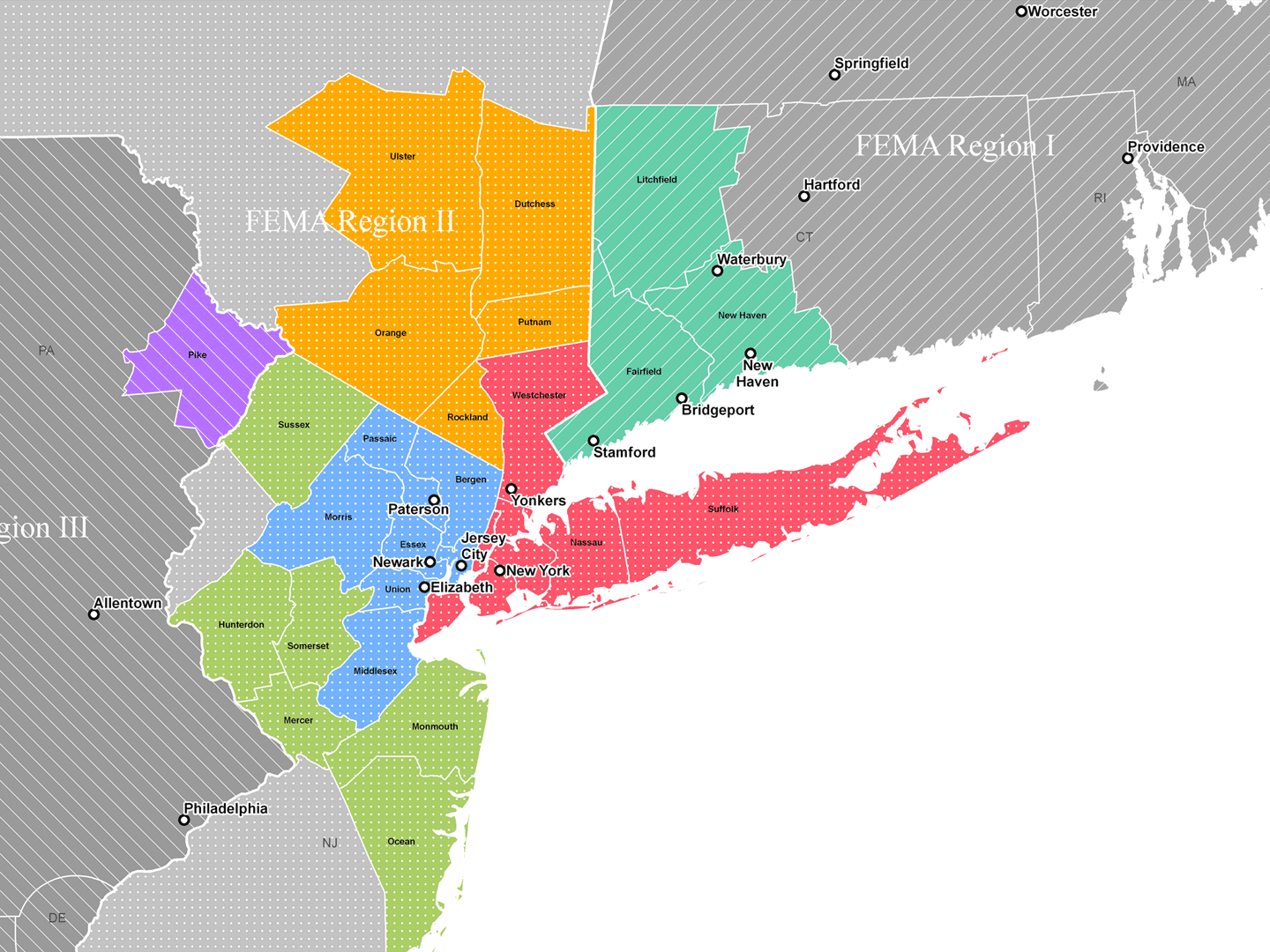
New Plans: Regional Catastrophic Planning
In 2010 and 2011, the Regional Integration Center, the working arm of the Regional Catastrophic Planning Team, created regional plan capabilities for evacuation and sheltering, radiological response, disaster housing recovery, critical infrastructure protection, debris management, continuity of operations, disaster logistics planning, and private sector integration, including affiliated and non-affiliated volunteers. A joint project of the New York City and the Northern New Jersey Urban Area Working Groups, the Regional Catastrophic Planning Grant Program improves catastrophic preparedness by linking regional operational capabilities, resources, and plans. The geographical area represented by the Regional Catastrophic Planning Team includes New York City, the cities of Newark and Jersey City, the State of New Jersey, as well as Bridgeport, Connecticut, and Pike County, Pennsylvania. The population of this 12,000-square-mile area is approximately 22 million people, representing one in 14 Americans.
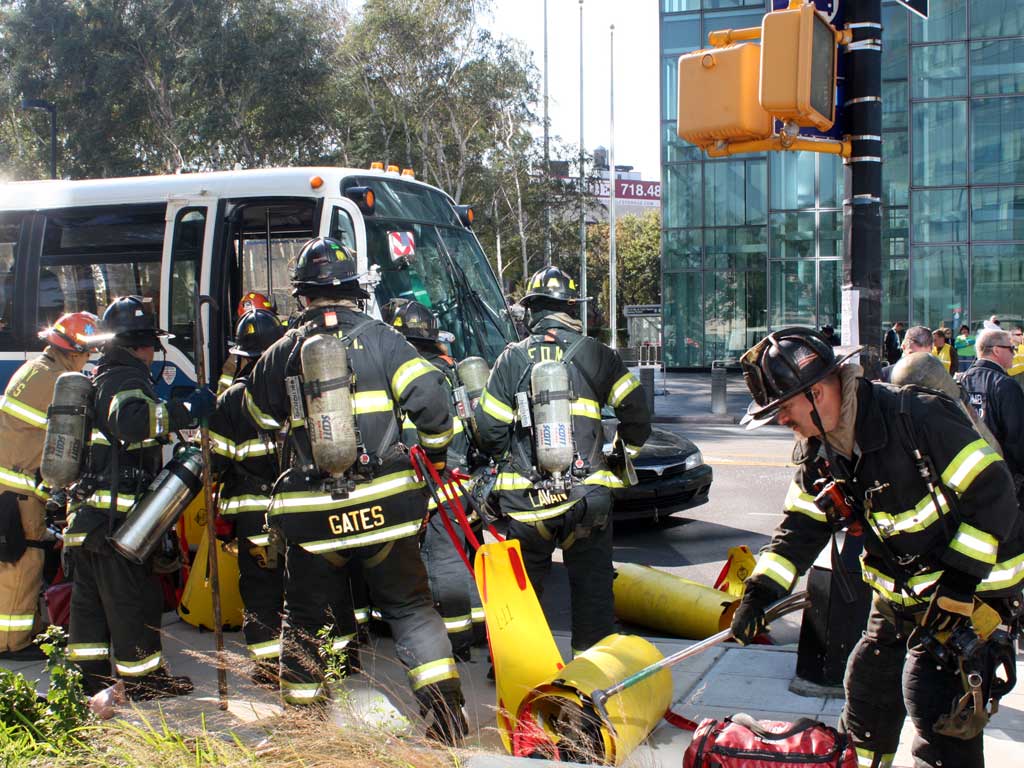
Training and Exercises: NYC Resilience
Between August and October 2010, OEM and 10 City agencies participated in NYC Resilience — a six-part exercise series designed to test the City's response to a terrorist attack involving multiple car bombings. More than 1,000 first responders and volunteers participated in NYC Resilience, which addressed skills including search and rescue, medical triage, law enforcement and investigation, and victim and family assistance. Participating agencies were also challenged to respond to a mass-casualty incident, which required the activation of the Unified Victim Identification System, and execution of the City's Family Assistance Center plan.

Training and Exercises: CERT in NYC Resilience
NYC Community Emergency Response Team (CERT) volunteers, donning makeup to give them the appearance of bombing victims, helped add an element of realism to the NYC Resilience drill. Their involvement allowed first responders to care for and question live victims during the exercise. CERT members also played family members searching for victims at the City's Family Assistance Center as part of the drill.
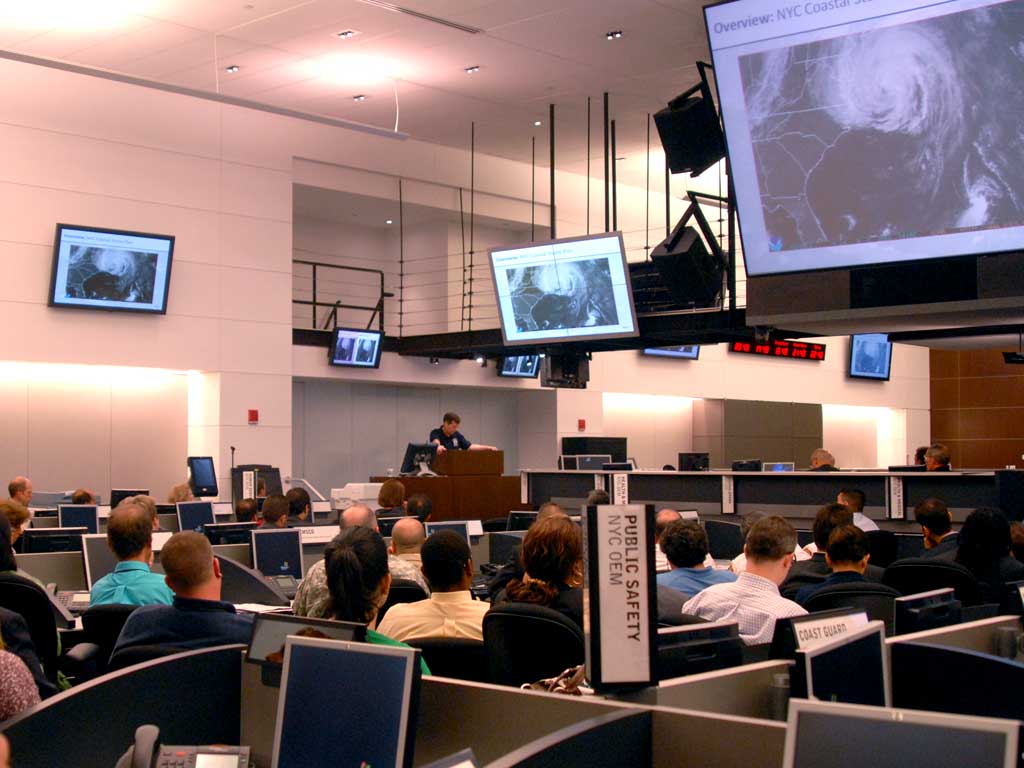
Training and Exercises: Eyeing the Storm
In July 2011, 200 City officials from 50 agencies along with non-profit and private organizations gathered in the City's Emergency Operations Center at OEM headquarters to simulate the City's actions leading up to a major hurricane hitting New York City. City executives were challenged to decide whether to recommend the Mayor order a mass evacuation in light of Hurricane Julia, a hypothetical Category 3 storm projected to impact the New York City area in 84 hours. Nine Emergency Support Function working groups considered challenges and agency responsibilities related to coastal storm evacuation and sheltering, including transportation, public messaging, and assisting people with special needs. The exercise helped to inform the pre-storm decisions that City officials made six weeks later as Hurricane Irene headed toward New York City –following almost the same track as the fictional Hurricane Julia.
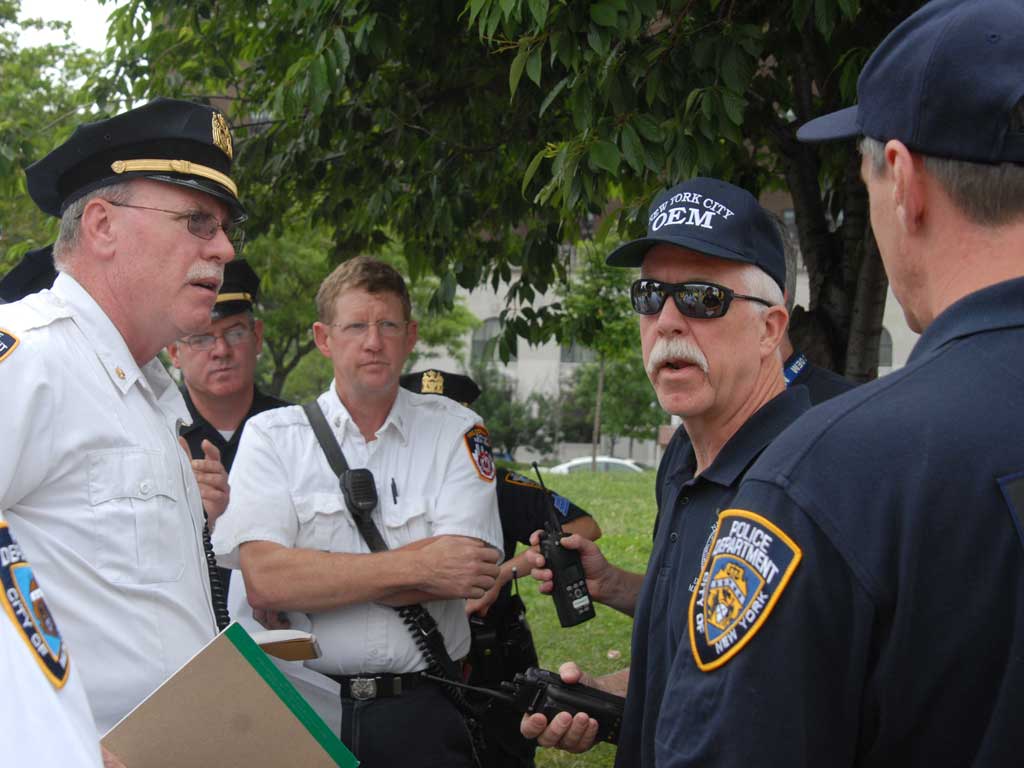
Training and Exercises: Field Response Observation Program
In March 2011, OEM launched the Field Response Observation Program, a three-day course during which staff participants shadow OEM Citywide Interagency Coordinators as they respond to real incidents and events across the city. This program allows OEM's non-response staff to gain a greater understanding of OEM field operations and witness firsthand how the Citywide Incident Management System is implemented. Twenty OEM staff members completed the program in 2011. Trainees observed incidents including a bus crash, a supermarket evacuated due to high carbon monoxide readings, an interagency meeting for a major synagogue fire, and a four-alarm alarm fire at a DEP sewage treatment plant.
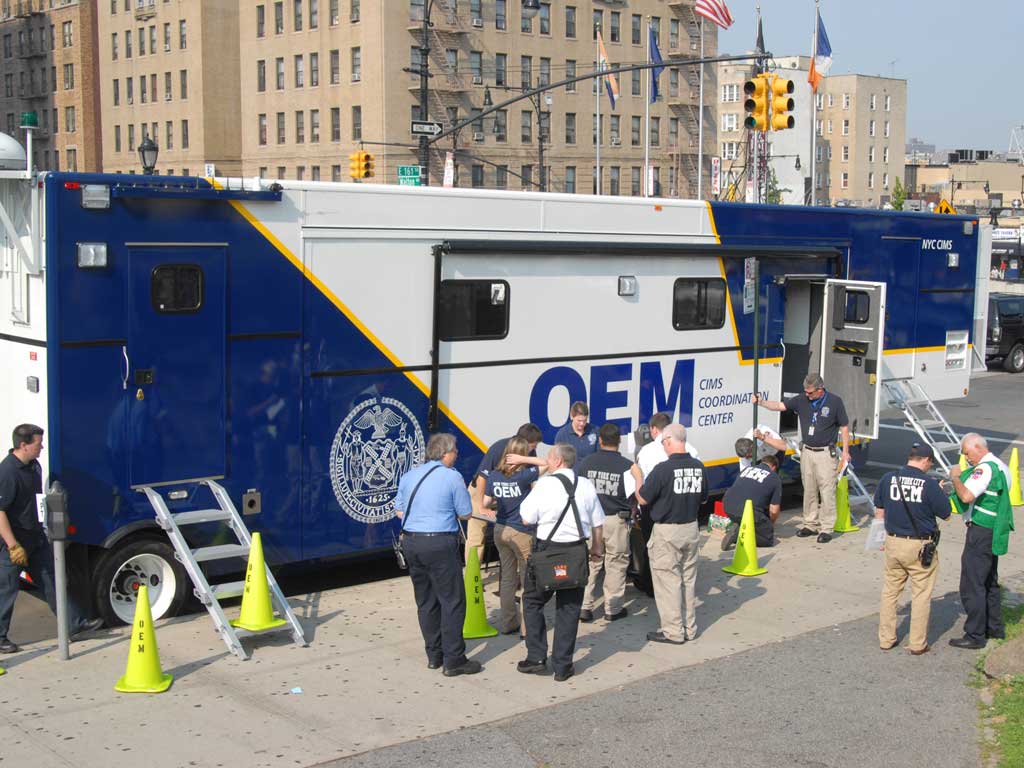
Training and Exercises: Command Post Exercises
In June 2011, OEM and the Fire and Police Departments began a series of command post exercises designed to test Fire and Police personnel's ability to establish a Unified Command Post and Operations Section for complex incidents. In each drill, players were challenged to make joint decisions and share information when presented with a subway terrorist incident scenario.
Command Post Exercises
OEM and Fire Department staff set up the mobile CIMS Coordination Center for the first command post exercise in the Bronx. Exercise controllers used the CIMS vehicle as their staging ground to manage the master scenario, introduce new details about the unfolding scenario by radio and phone, and track the exercise progress.
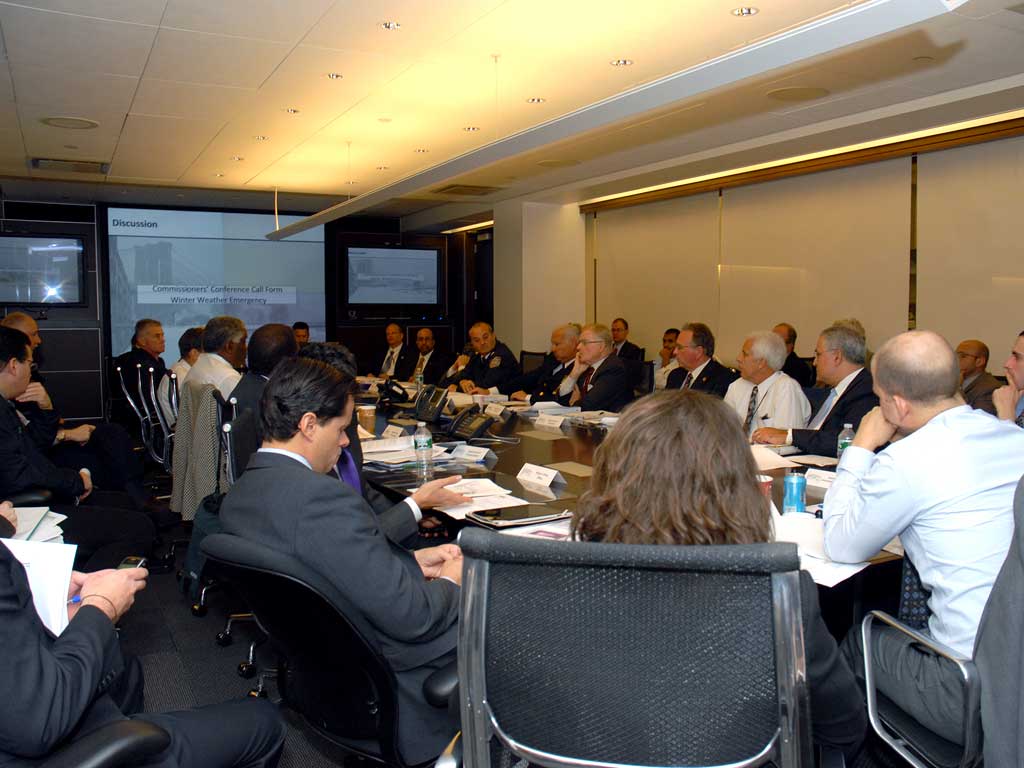
Training and Exercises: Winter Weather Executive Tabletop
On November 2, 2011, OEM hosted an executive decision-making tabletop exercise for agencies that play a major role in the City's Winter Weather Emergency Plan. The Deputy Mayor for Operations joined several agency heads as they were challenged to decide whether to declare a snow emergency ahead of a snow storm due to arrive in the city on New Year's Eve. The exercise also tested the 15-Point Action Plan recommended by the Mayor to address problems the City encountered following the December 2010 blizzard.
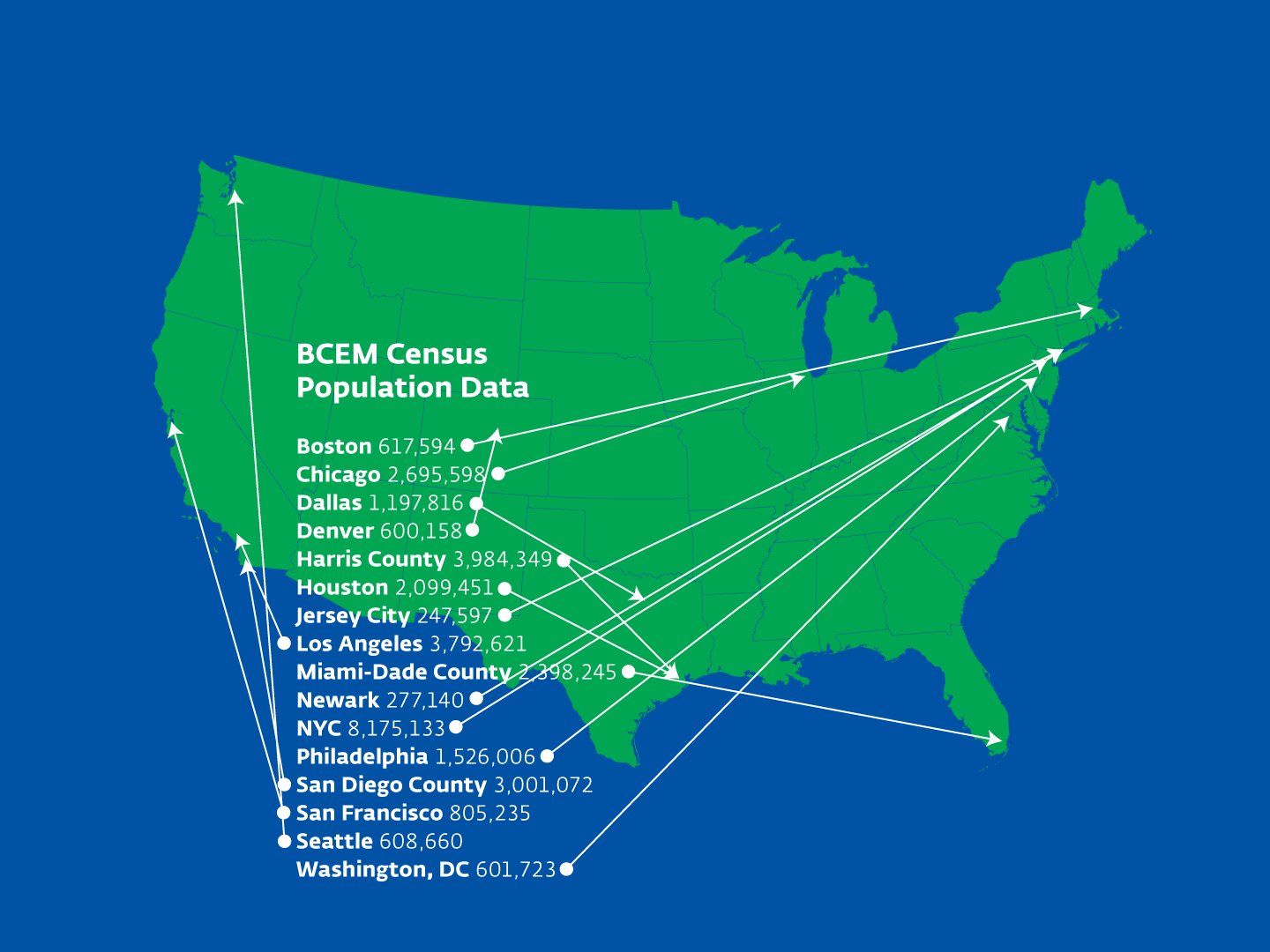
Training and Exercises: Big City Emergency Managers
As part of OEM's continuing leadership role throughout the region and the nation, the agency welcomed the Big City Emergency Managers (BCEM) to New York City in October 2011 for its fall conference. BCEM, which includes top emergency management officials from 15 cities and metropolitan regions representing more than 32 million people, met to discuss lessons learned from Hurricane Irene, post-disaster housing, emergency sheltering, nuclear power plant preparedness, and the future of emergency management, among other topics.

Educate the
Public

National Preparedness Month
Every September, OEM and the NYC Citizen Corps Council kick off National Preparedness Month — a nationwide campaign to promote emergency preparedness and encourage volunteerism — with emergency preparedness events in all five boroughs. During September 2011, OEM hosted 57 emergency preparedness events, registered almost 2,000 people for the City's Notify NYC emergency notification service, and teamed up with hundreds of public and private sector partners to prepare employees and volunteers through the Partners in Preparedness program.
National Preparedness Month
In honor of National Preparedness Month, OEM closed the NASDAQ in Times Square on September 1, 2011.
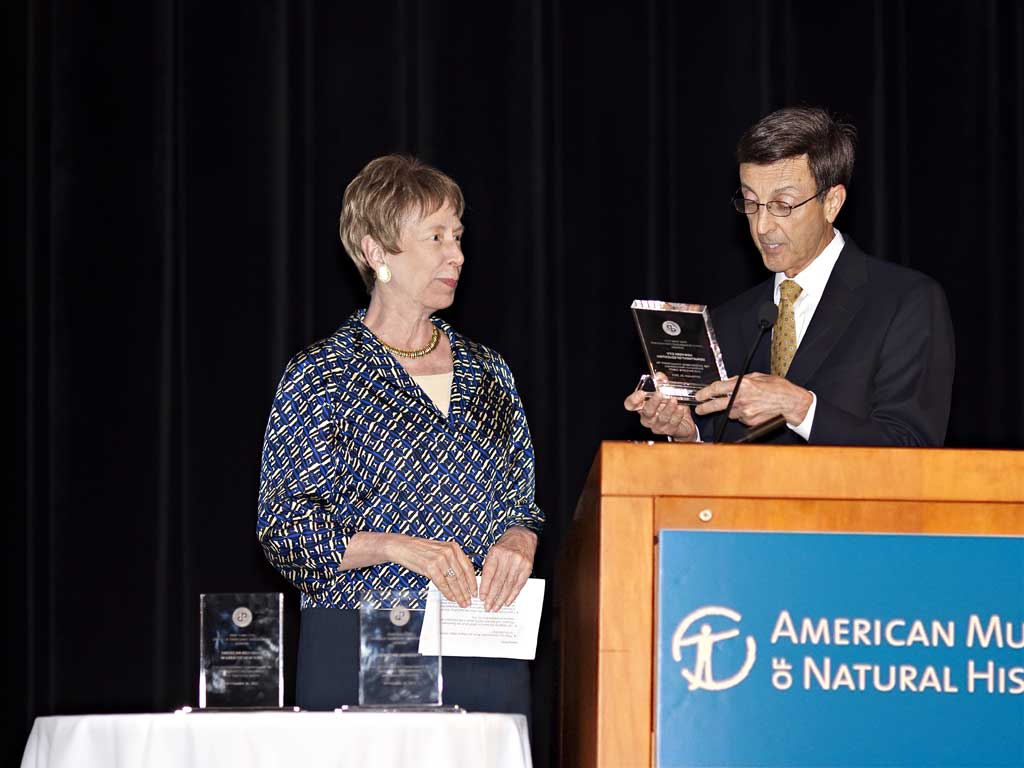
Partners in Preparedness
Introduced in September 2011, OEM's Partners in Preparedness program challenges businesses, non-profits, faith-based, and government organizations to prepare their employees and volunteers for emergencies by completing at least five preparedness activities.
Participating organizations received an official Partners in Preparedness seal and recognition on OEM's website. In 2011, 65 organizations representing more than 350,000 employees completed activities like encouraging co-workers and volunteers to register for Notify NYC, conducting a fire drill, and creating and testing emergency contact plans to qualify as 2011 Partners in Preparedness.
Partners in Preparedness
Deputy Chancellor Kathleen Grimm accepts the 2011 Partners in Preparedness Award on behalf of the NYC Department of Education. Through the Ready Schools program supported by the Department of Education, over 30,000 students at more than 100 schools received emergency preparedness training in the 2009-10 and 2010-11 school years.
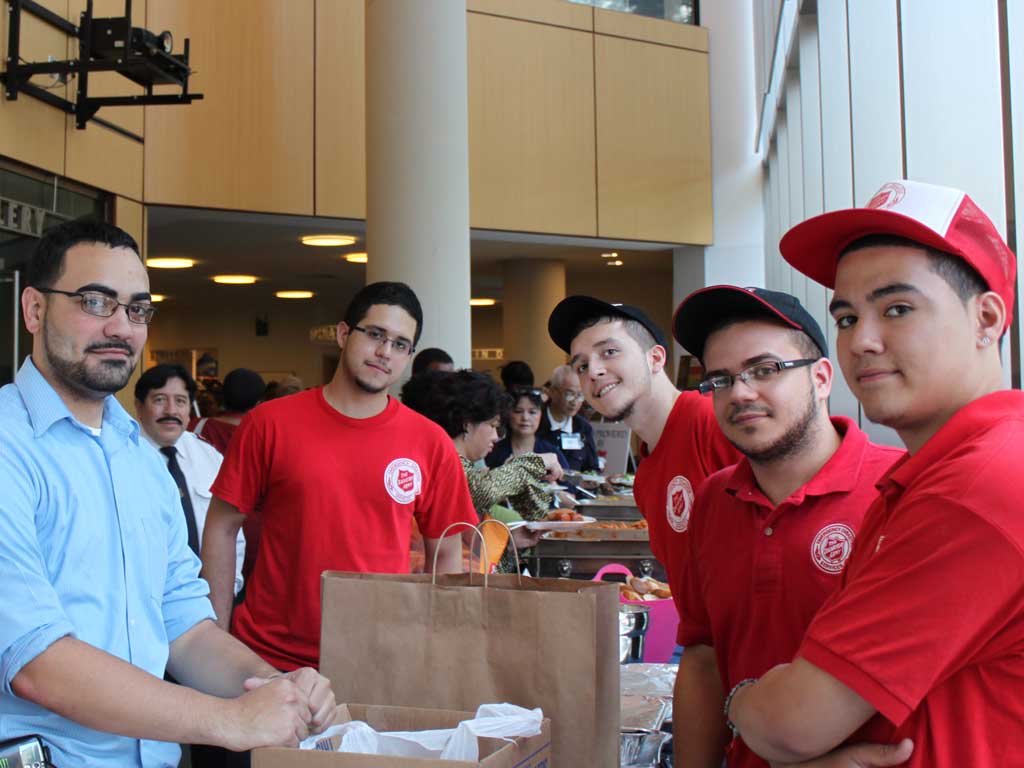
Disaster Volunteer Conferences
In May 2010, more than 250 New Yorkers, representing 10 disaster volunteer organizations, attended the annual NYC Citizen Corps Council disaster volunteer conference to learn strategies to cope with the stress of volunteering before, during, and after a disaster. In May 2011, the disaster volunteer conference celebrated New York City's diverse communities and brought together more than 200 leaders from the volunteer, faith-based, immigrant, special needs, and academic communities to discuss how volunteers can play a role in enhancing cross-cultural communication before, during, and after a disaster.
Disaster Volunteer Conference
During the 2011 Disaster Volunteer Conference, the Salvation Army used volunteers to test a plan to feed large numbers of people during an emergency. As part of the exercise, volunteers distributed meals to conference participants.
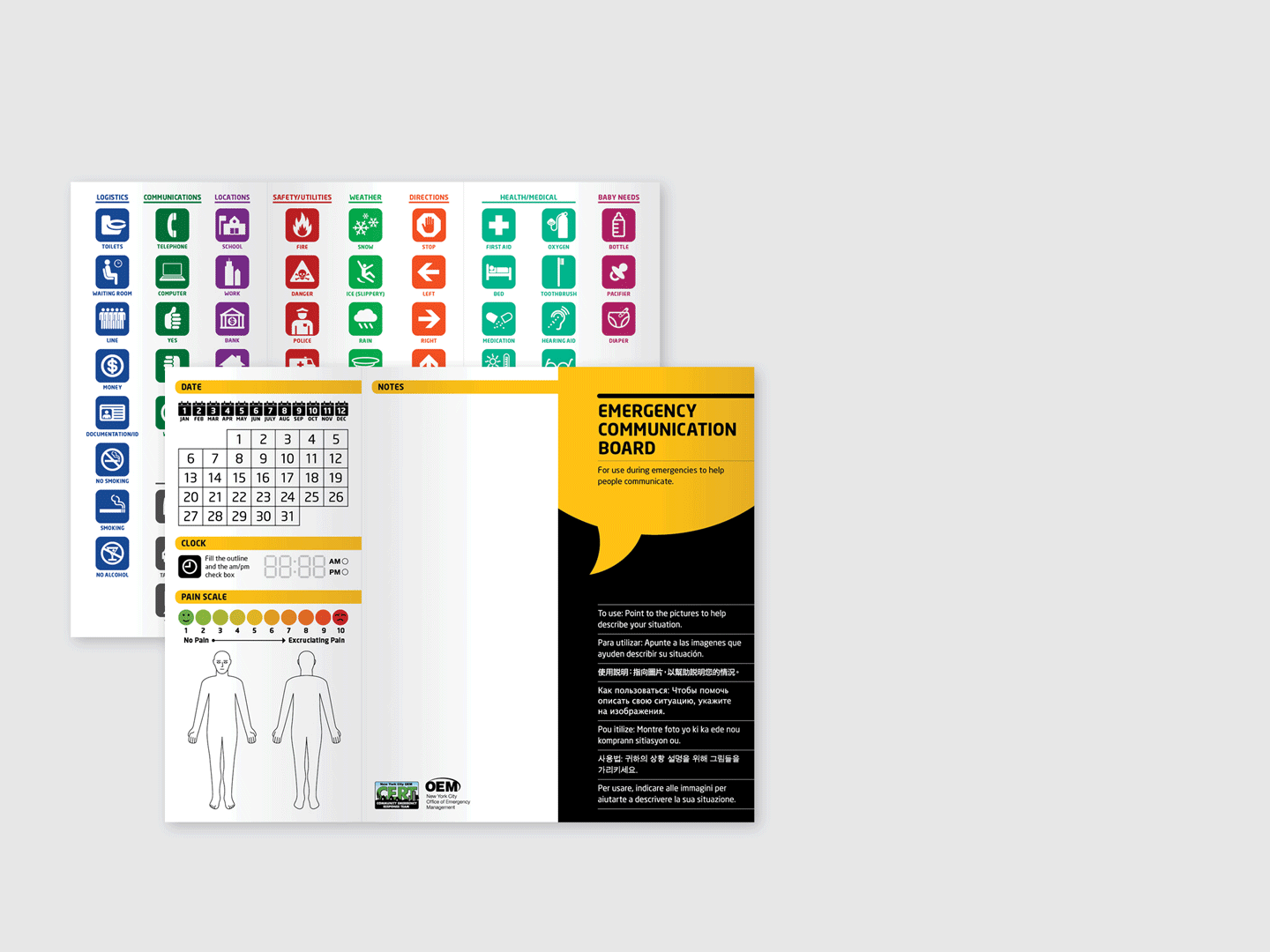
Language Access Protocol and Training
To address the needs of diverse New Yorkers to receive emergency services in their own languages, OEM released the Language Access Protocol in January 2011. The protocol contains a form to assess interpretation and translation needs in the field, information about which agencies handle language access issues, a list of interpretation services, and recommendations for how best to use these resources. OEM also developed a language access familiarization course that all staff members are required to complete.
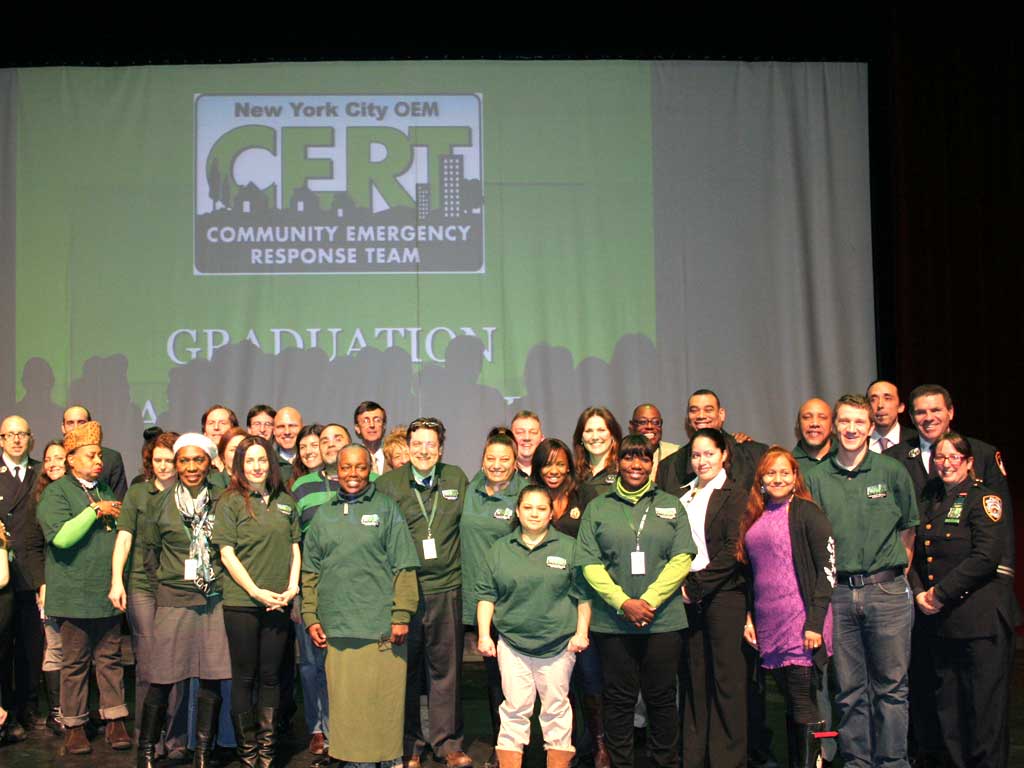
CERT: Program Growth
The NYC Community Emergency Response Team (CERT) program started in 2003 with 106 volunteers. Today, the City has 57 CERT teams with more than 1,500 volunteers representing all five boroughs. In addition to assisting first responders during emergencies, CERT volunteers play an important role in community events and preparedness training. In 2010, CERT members were deployed to assist with the Five Boro Bike Tour, where they directed traffic at designated rest areas. In 2011, CERT volunteers assisted at the World Police and Fire Games, the second largest multi-sport event in the world. CERT volunteers also assisted family members of the victims involved in a fatal Bronx bus accident in March 2011 and helped staff evacuation shelters during Hurricane Irene in August 2011.
CERT: Program Growth
In January 2011, OEM hosted a graduation ceremony for 122 CERT volunteers. The new graduates of CERT Cycle 16 completed an intensive, 10-week training program in disaster preparedness and basic emergency response skills.

CERT: Haiti Deployment
In June 2010, during the recovery from the devastating January earthquake, an 11-member team from OEM, the Fire Department, and the Health Department traveled to Port-au-Prince, Haiti, to help create a local Community Emergency Response Team (CERT) program. Over a 10-day period, the team trained 412 Haitians in basic emergency response skills, including fire safety, first aid, triage, strategies to combat civil unrest, light search and rescue, public health, water safety, and disaster psychology. The new Haitian CERT members trained by New York City instructors now help develop the program in other parts of Haiti. This collaboration marked the first time the New York City CERT trainers taught the CERT program outside the United States.
CERT: Haiti Deployment
New York City CERT instructors helped to train Haitians in fire safety, teaching the Haitian CERT members how to use everyday tools and materials, like shovels and dirt, to help fight fires.
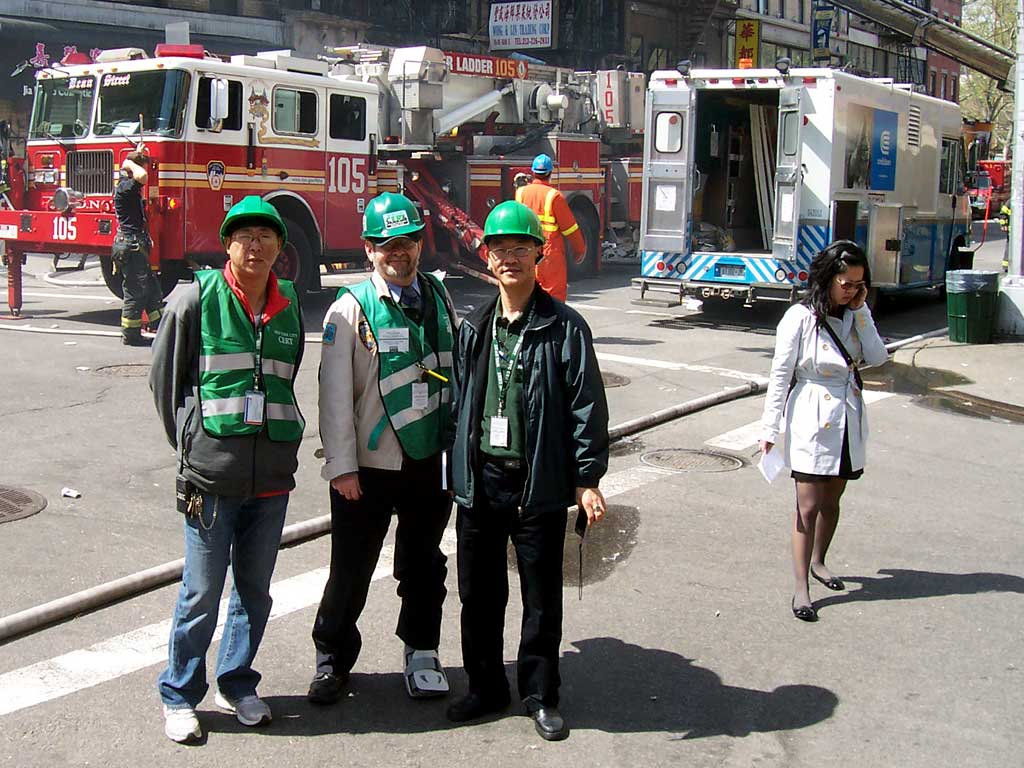
CERT: Chinatown Fire
On April 11, 2010, a seven-alarm fire displaced hundreds of residents in Manhattan's Chinatown. Volunteers from the local Community Emergency Response Team (CERT) joined the City's first responders to help secure the scene and assist residents. CERT members from Manhattan Community District 3 served as interpreters and helped connect affected residents with City services.
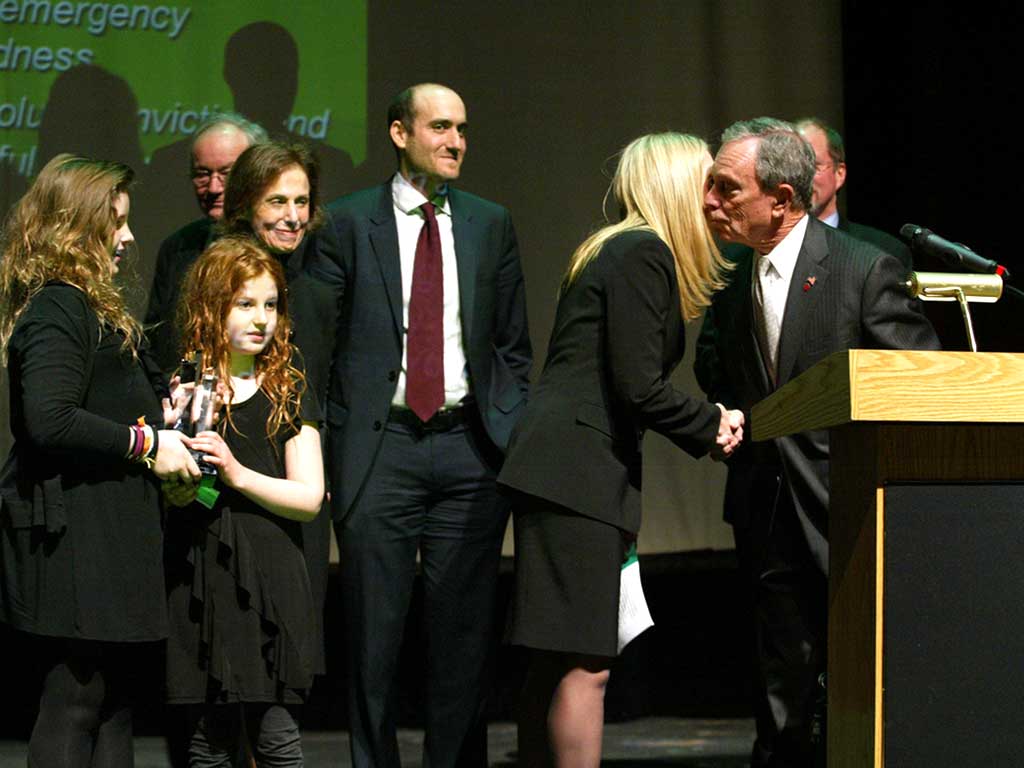
CERT: John D. Solomon Award
In January 2011, OEM created a new emergency preparedness award to honor the late John D. Solomon. John was an active member of the Upper East Side CERT until his untimely death. He made emergency preparedness his life's work and labored tirelessly to involve the community in his preparedness efforts. The John D. Solomon NYC CERT Award for Exemplary Service in Emergency Preparedness Education will be presented annually to a CERT member who shows outstanding dedication to the program and embodies Solomon's enthusiasm for volunteerism and emergency preparedness education.
Photo Credit: Kristen Artz
CERT: John D. Solomon Award
Members of John Solomon’s family, including his wife Abby, his brother James, his parents, and his daughters, joined Mayor Bloomberg in announcing the annual John D. Solomon NYC CERT Award for Exemplary Service in Emergency Preparedness Education.
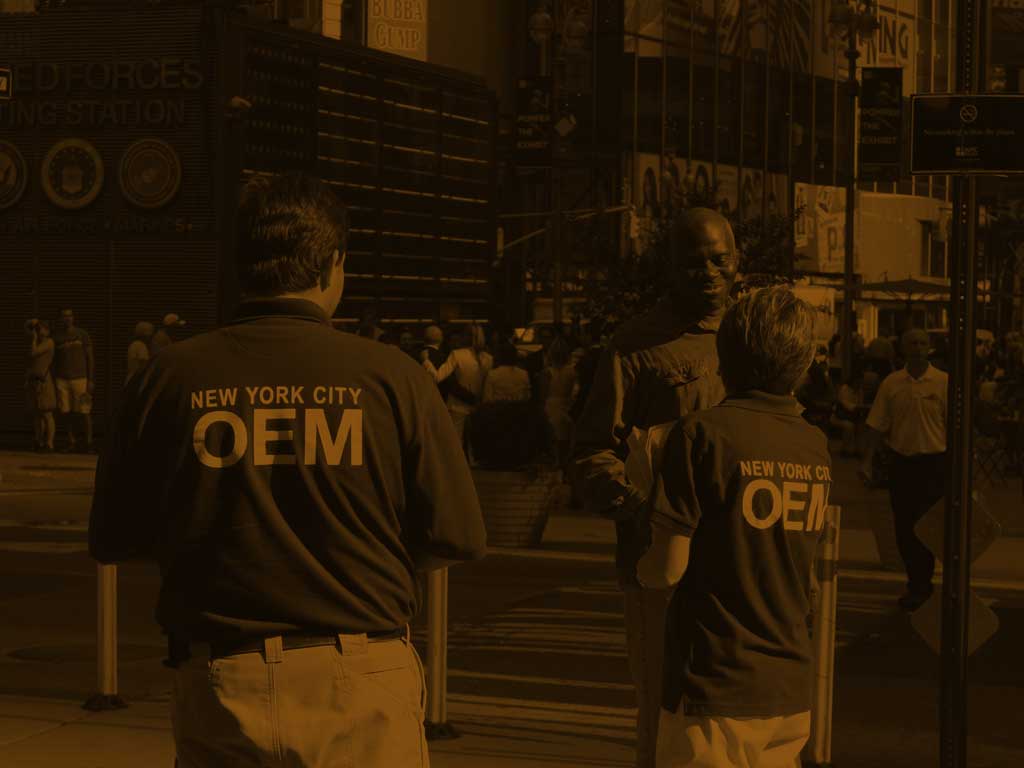
Ready NY: Stats
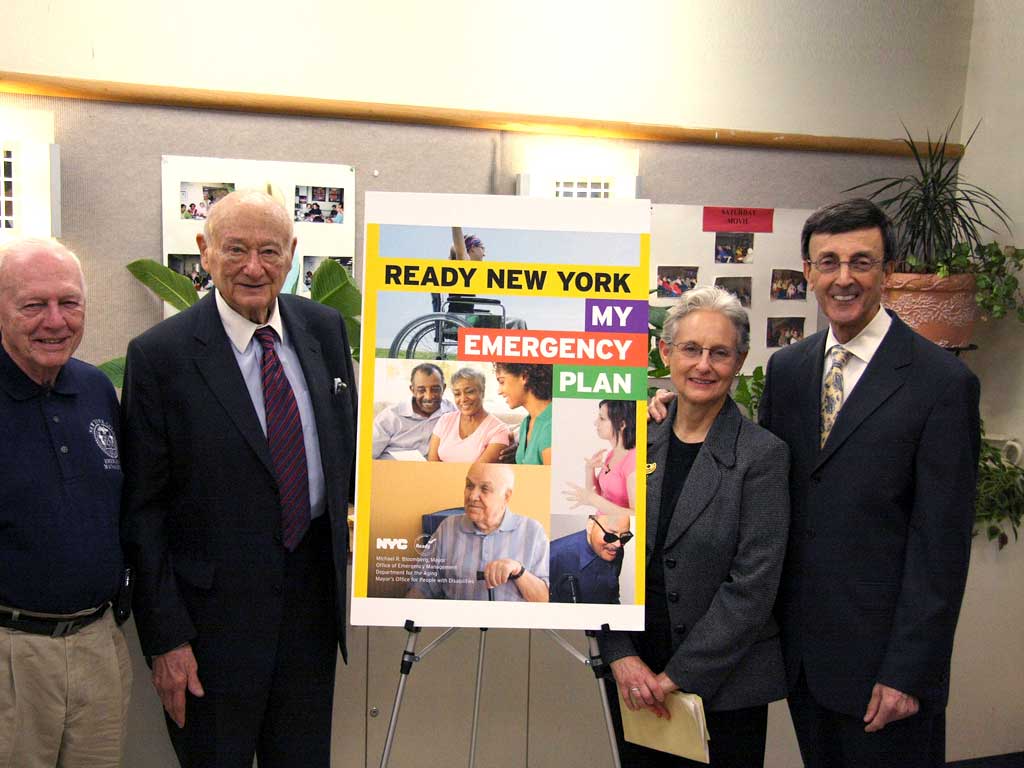
Ready NY: My Emergency Plan Guide
In October 2011, OEM introduced a new interactive preparedness guide designed to help seniors and people with disabilities create an emergency plan. Ready New York: My Emergency Plan is a joint effort between OEM, Department for the Aging, and Mayor's Office for People with Disabilities. My Emergency Plan walks users through establishing a support network, capturing important health information, evacuation planning, and gathering emergency supplies. First responders or caregivers can also use the completed workbook to assist people with special needs during an emergency. The guide is available in seven languages and in audio format on OEM's website and via 311.
Ready New York: My Emergency Plan Guide
Commissioner Bruno is joined by Department for the Aging Commissioner Lilliam Barrios-Paoli, former Mayor Ed Koch, and OEM’s own Frank Lowe at the Lenox Hill Senior Center in Manhattan to launch the new Ready New York: My Emergency Plan guide.

Ready NY: Ready Schools
In June 2011, OEM and the Department of Education presented the Ready School of the Year Award to PS 97, the Forest Park School, in the Woodhaven section of Queens, for the school's ongoing commitment to emergency preparedness education. In 2010, PS / IS 18, the Park Terrace School, in upper Manhattan, received the award. Over 30,000 students at more than 100 schools received Ready Schools emergency preparedness training in the 2009-10 and 2010-11 school years.
Ready NY: Ready Schools
Students at PS 97 in Queens present Commissioner Bruno with a mural after receiving the Ready School of the Year Award. The mural, which highlights emergency preparedness, is currently on display at OEM headquarters.
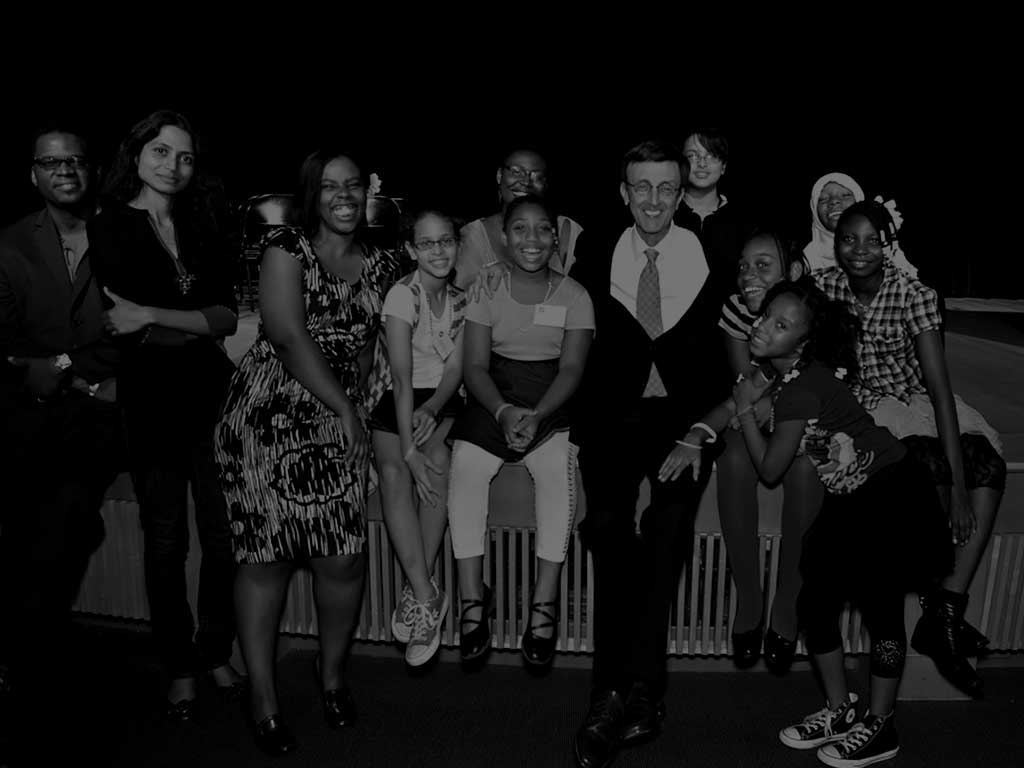
Ready NY: Cartoons
In August 2011, OEM worked with students at the Police Athletic League Beacon Camp at the Goldie Maple Academy in Rockaway Queens to create original emergency preparedness cartoons. The campers drew original cartoon characters, wrote scripts, and recorded voice-overs and songs. The cartoons debuted at OEM's Partners in Preparedness reception at the American Museum of Natural History in September, and can be viewed on OEM's website, Facebook and YouTube pages.
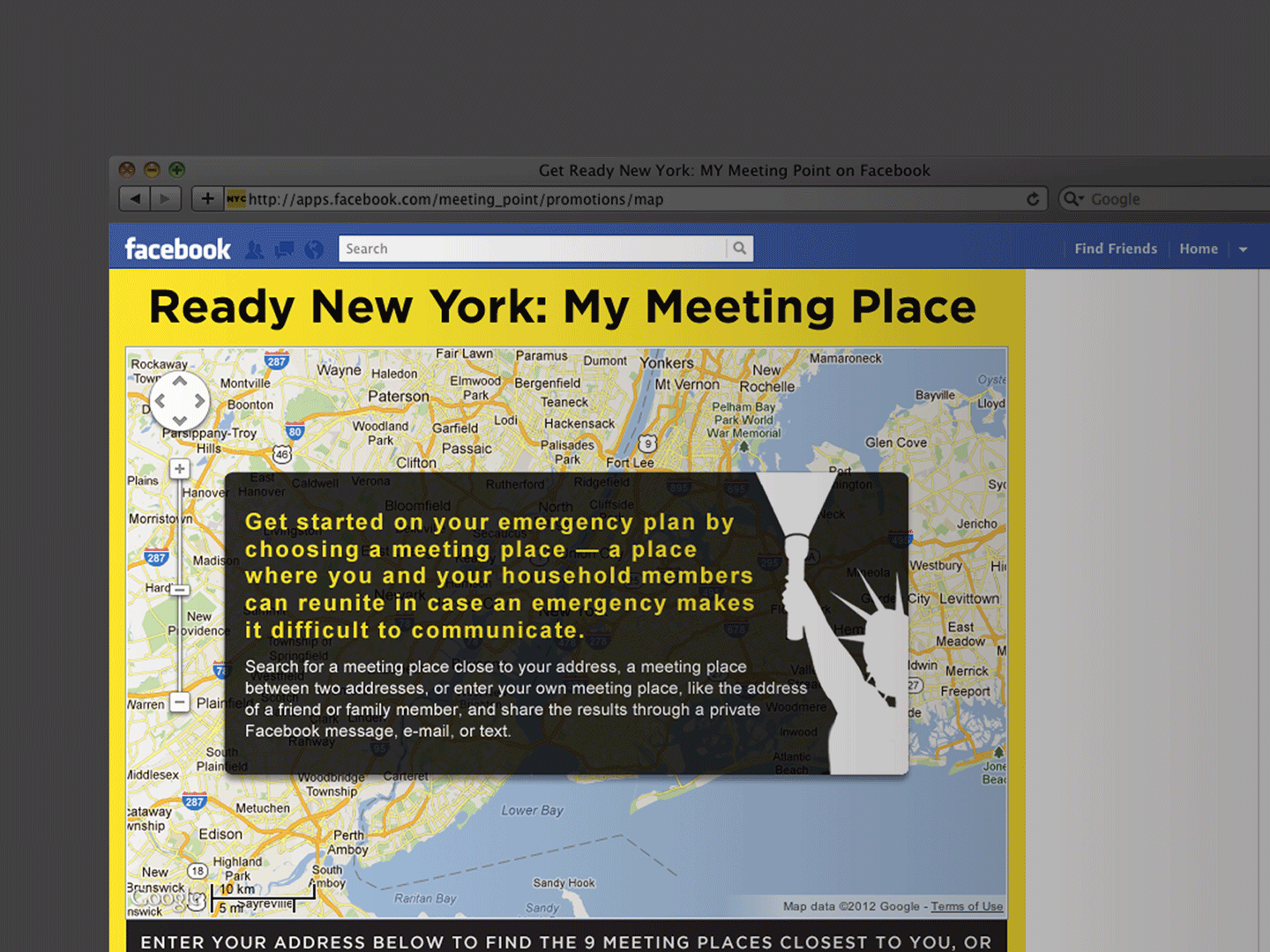
Ready NY: Meeting Place App
OEM and the Ad Council launched the Ready New York: My Meeting Place application on Facebook in 2010 to help New Yorkers find a safe place to meet their families or friends during an emergency. Located on OEM's Facebook page, the interactive web mapping application allows New Yorkers to select a meeting place from thousands of locations in the metropolitan area. The selected meeting place can be privately shared via e-mail or text. More than 12,000 users have accessed the app since its launch.
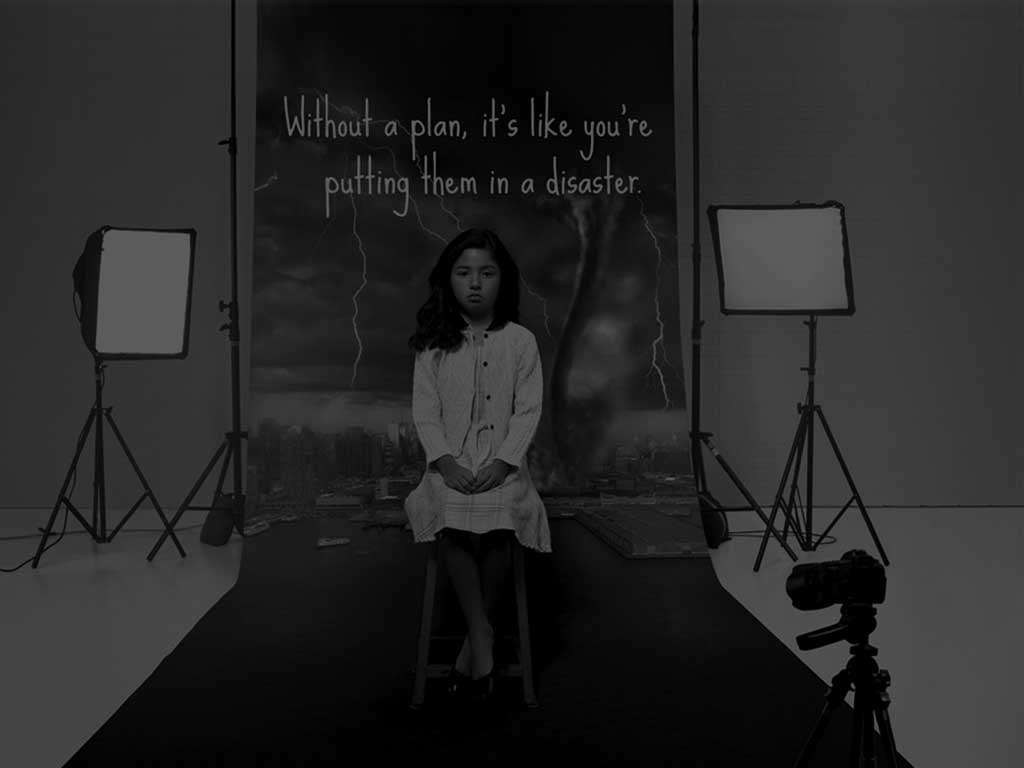
Ready NY: Ad Council Campaign
In September 2011, OEM and the Ad Council unveiled new print and radio public service advertisements (PSAs) as part of the Ready New York emergency preparedness ad campaign. Since the campaign's launch in September 2009, media outlets have donated more than $17 million in media support. The latest radio, web banners and outdoor PSAs were designed pro bono by ad agency Cramer-Krasselt and are available in both English and Spanish.
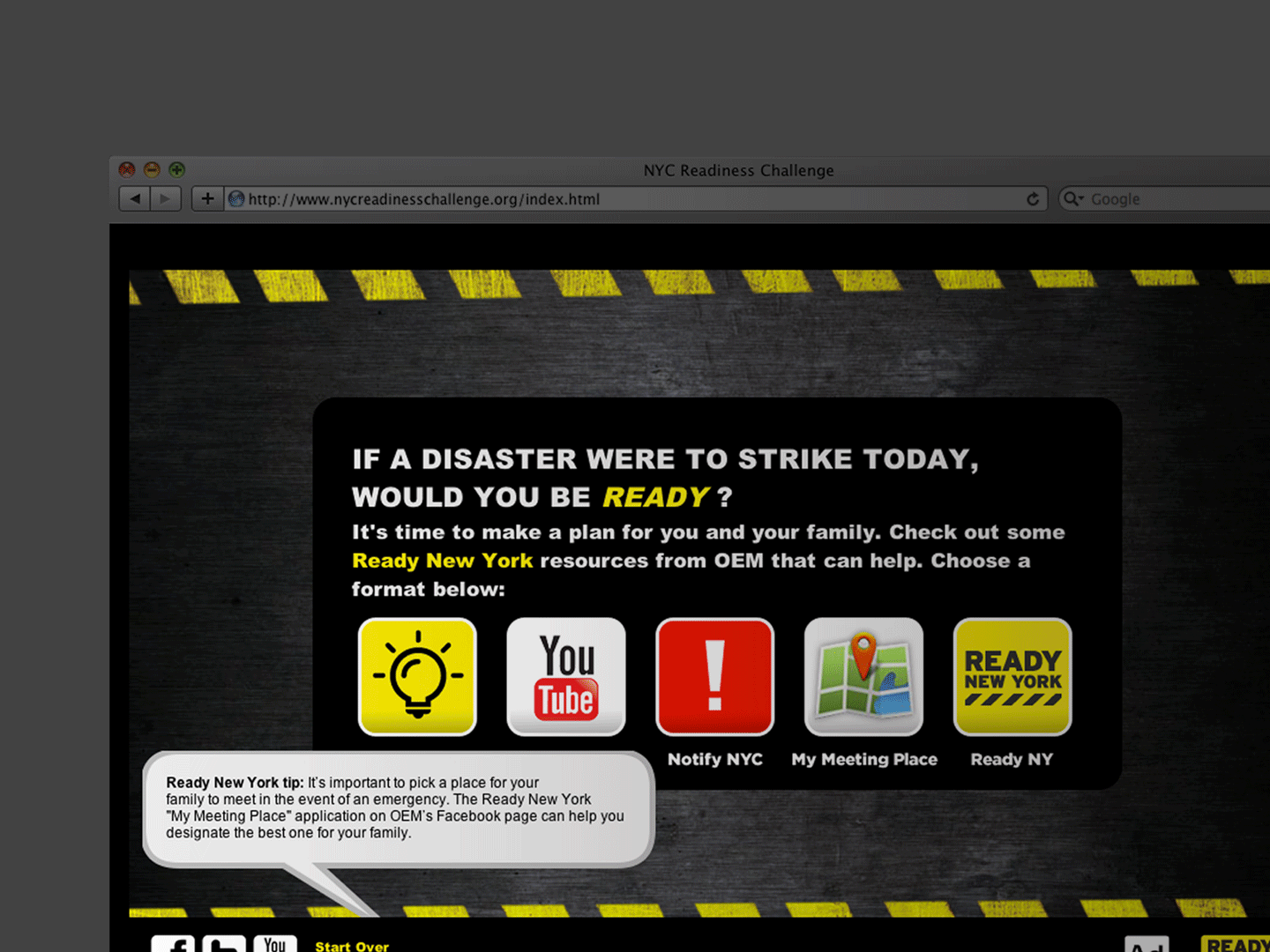
Ready NY: Ad Council Campaign Readiness Challenge
In September 2011, OEM and the Ad Council launched the interactive Readiness Challenge tool to help New Yorkers create an emergency plan. The Readiness Challenge walks users through a real-life emergency situation and challenges them to make quick decisions. In addition to demonstrating the importance of being prepared, the Readiness Challenge ties in the Ready New York: My Meeting Place Facebook application and other OEM resources to help users develop their emergency plans.

Coordinate
Response and
Recovery
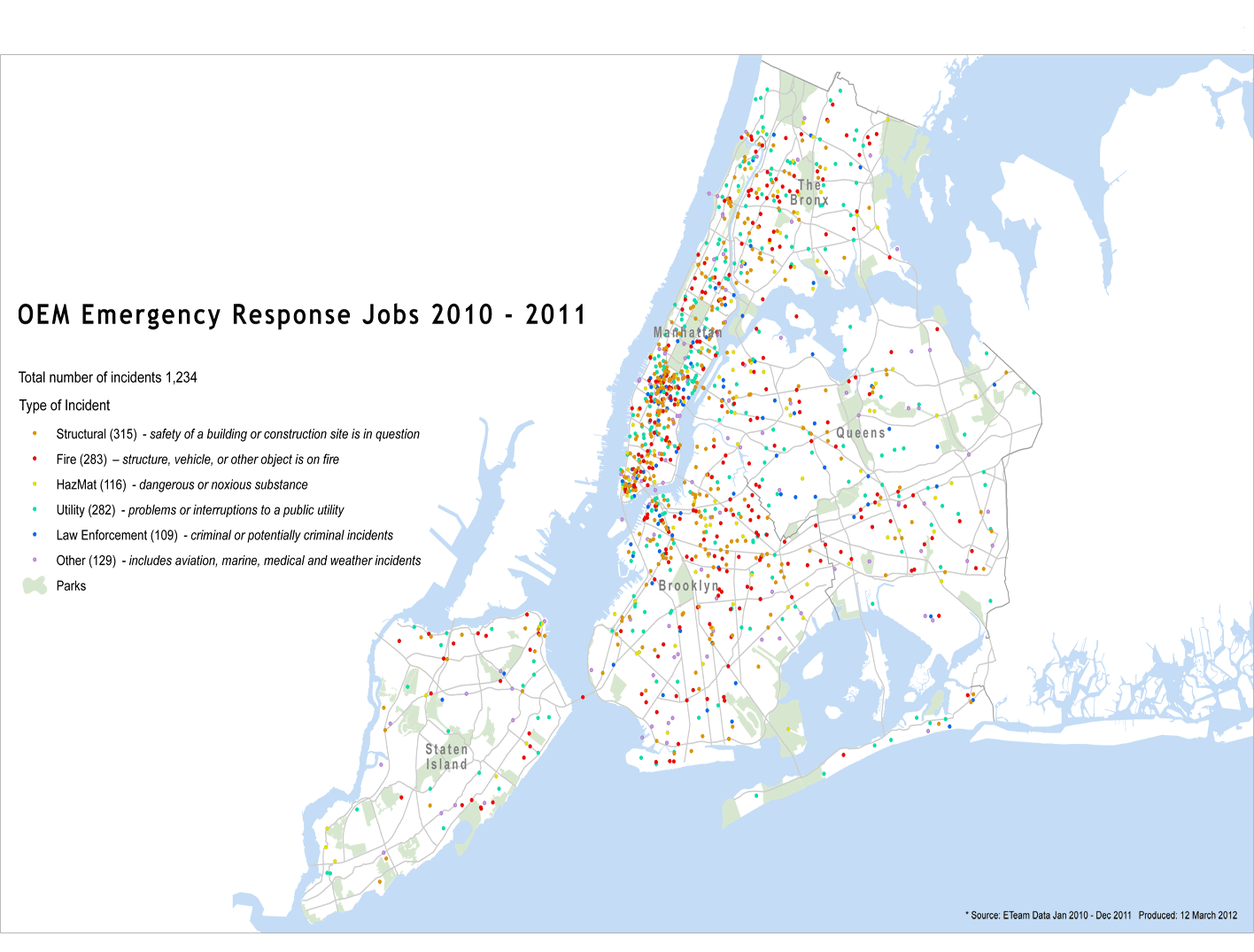
Operations: OEM Responses 2010-2011
In a city as large and complex as New York City, emergencies can happen every day. Between January 2010 and December 2011, OEM's Citywide Interagency Coordinators responded to almost 1,200 emergencies while Watch Command monitored more than 4,000 incidents in the five boroughs. Whether the City is responding to a structural collapse, hazardous material spill, or power outage, OEM coordinates the City's resources to ensure first responders have the information and resources they need.

Operations: Notify NYC
Notify NYC, the City's official source for emergency information, offers notifications and alerts by text message, e-mail, and phone. In January 2010, the Department of Education began offering messages about delayed school openings and early dismissals, student relocations, and temporary school closures to Notify NYC subscribers. In May 2010, the Police Department began sending missing person notifications for senior citizens — known as Silver Alerts - and AMBER Alerts for missing children through Notify NYC.
Notify NYC
By the end of 2011, Notify NYC had sent 1,573 emergency notifications since the program began.
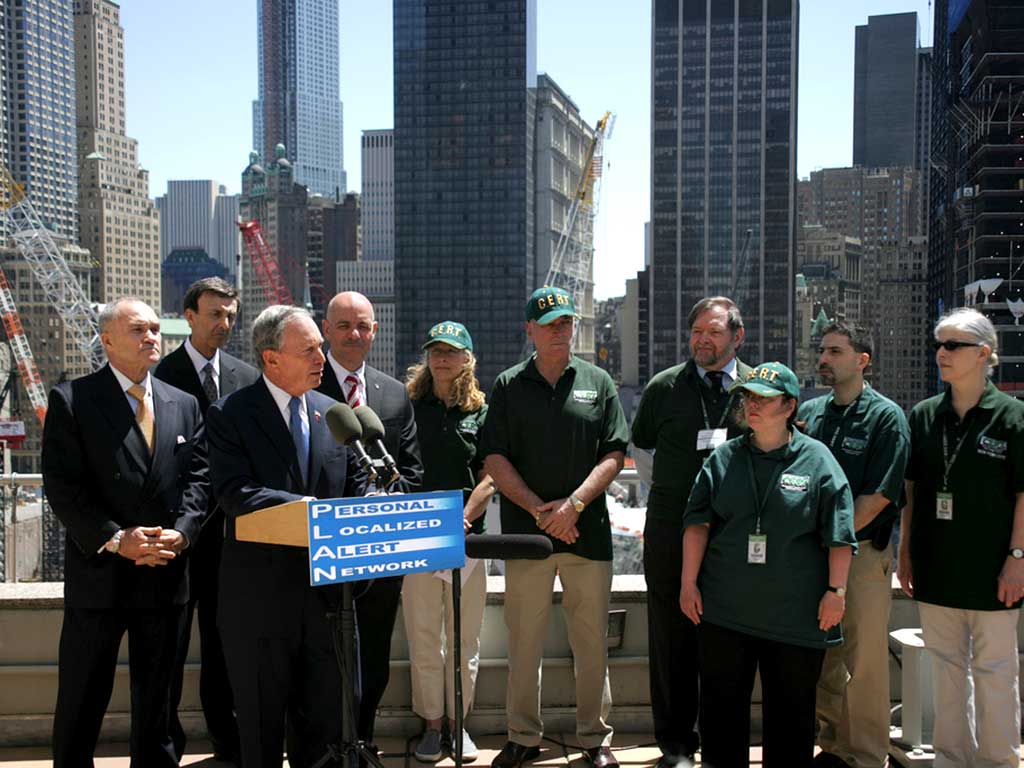
Operations: Notify NYC
In December 2011, the Federal Communications Commission and Federal Emergency Management Agency used Notify NYC to test a new emergency notification service that sends geographically targeted messages to enabled mobile devices. The service, known as PLAN — the Personal Localized Alerting Network — enables government officials to bypass network congestion and send messages through cell towers to properly configured mobile devices in the affected area.
Photo Credit: Edward Reed
Notify NYC
Commissioner Bruno joins Mayor Bloomberg, FDNY Commissioner Sal Cassano, and NYPD Commissioner Ray Kelly, and CERT volunteers in May 2011 to announce that the first-ever test of the Wireless Emergency Alerts system in the U.S. will take place in New York City. In December, CERT volunteers helped conduct the test using specially enabled phones.
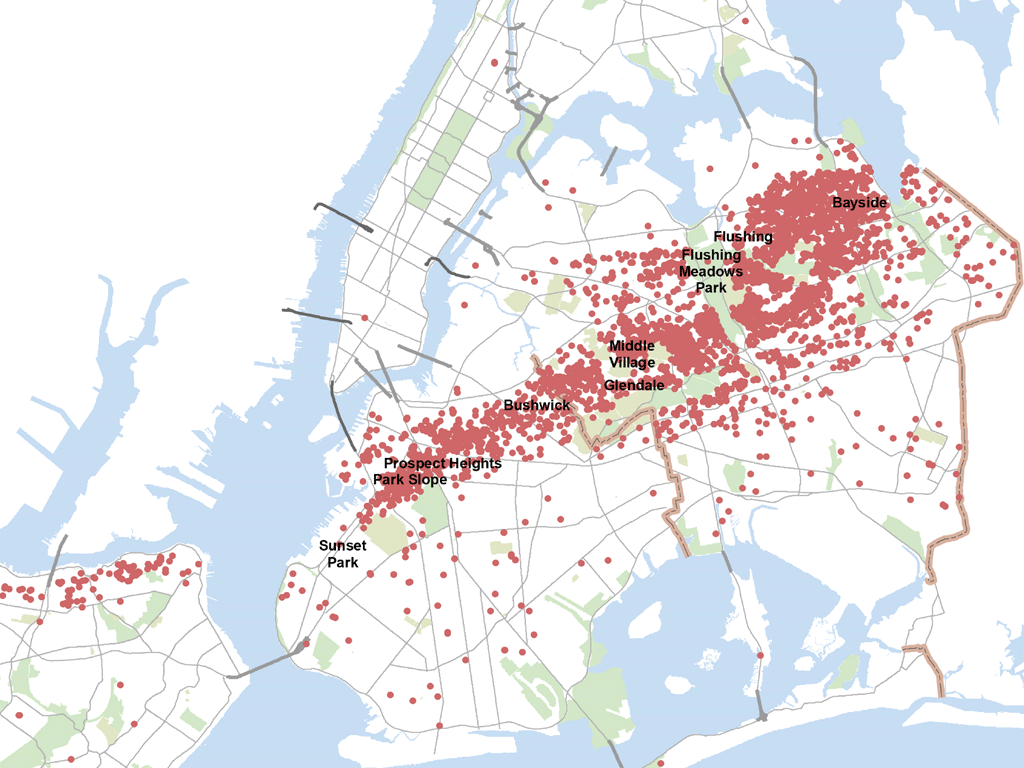
Operations: September 2010 Tornado Damage Reports
On September 16, 2010, two tornadoes and a macroburst (a sudden, powerful downward current of air) cut a 14-mile path of destruction through Brooklyn and Queens. Winds reached up to 125 miles per hour, tearing down trees and power lines throughout the city. The storm, part of a line of thunderstorms sliding across the Northeast, lasted a few minutes and caught evening commuters by surprise.
Tornado Damage Reports
- 7,870 calls to 311 to report tree damage
- Nearly 1,200 sidewalks damaged during the storm
- Visual: map of tornado damage reports
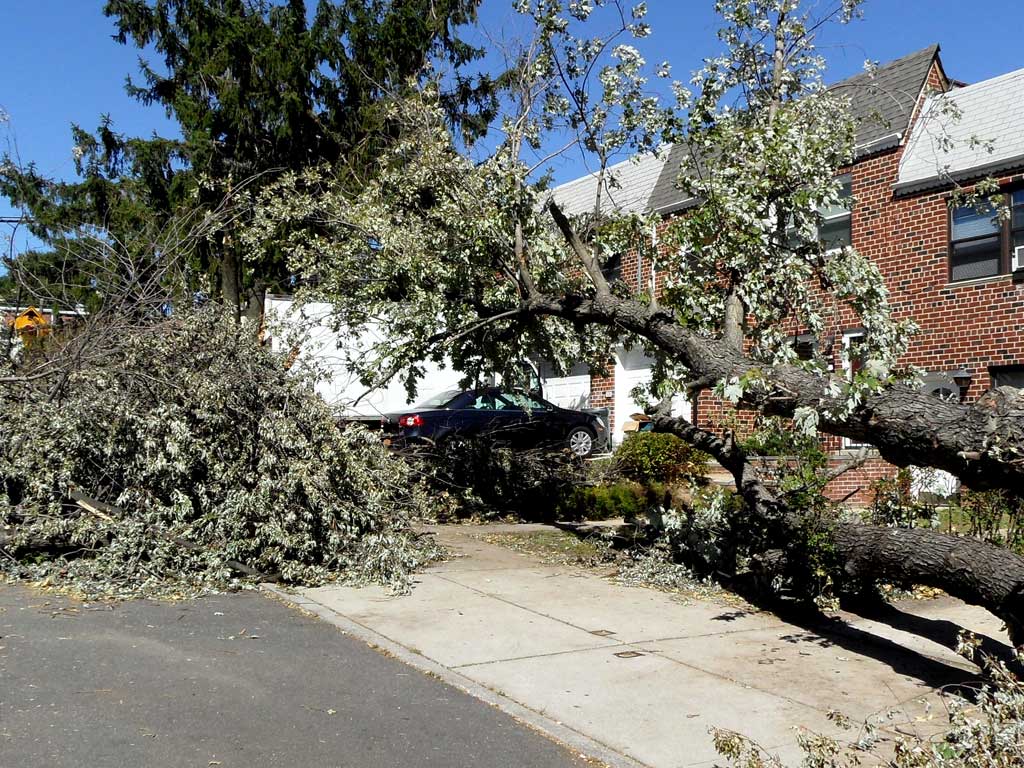
Operations: September 2010 Tornado — Downed Tree Task Force
To help manage resources and coordinate debris removal with recovery operations, the City created the Downed Tree Interagency Task Force, made up of representatives from OEM, Fire, Police, Parks, Sanitation, and Transportation Departments, Con Edison, National Grid, and the Metropolitan Transportation Authority, among others. The City removed more than 18,000 tons of debris from streets and parks during the first two weeks of the response, which is more debris than the City removes in an average year. After the recovery, the group established the Downed Trees Emergency Protocol, which explains how to clear the city of fallen trees and downed wires, as well as how the task force interacts with the City’s Emergency Operations Center. The Downed Tree Task Force was activated following Hurricane Irene in August 2011 to assist in clearing fallen trees and debris in the storm's wake.
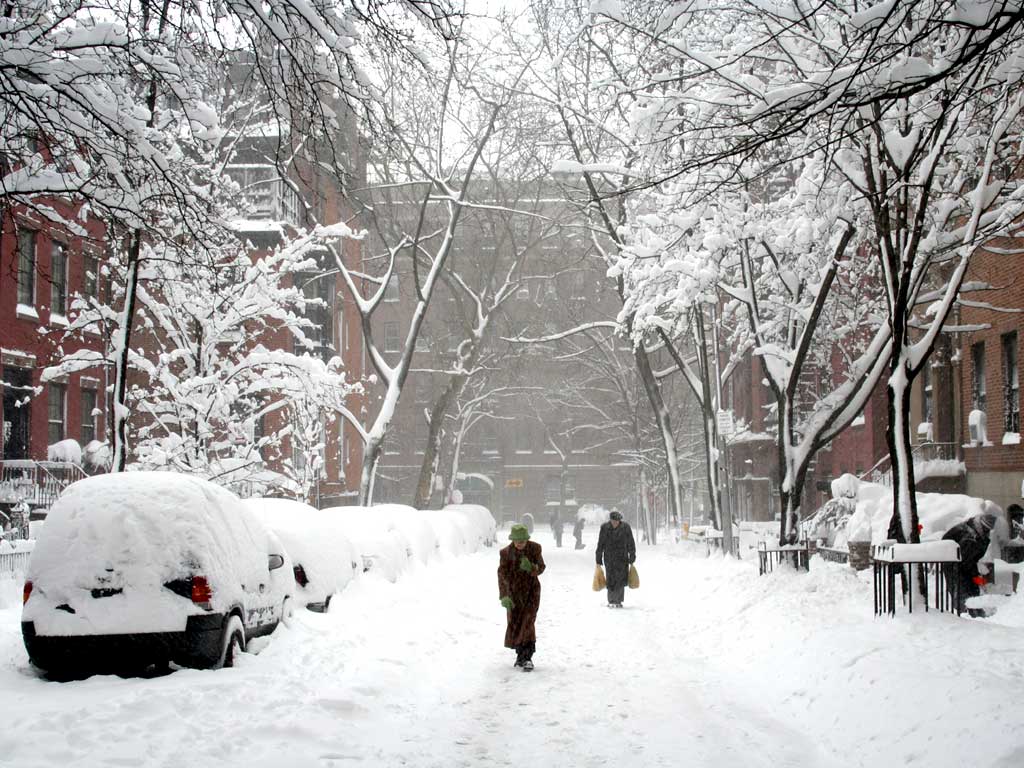
Operations: December 2010 Snowstorm
On December 26, 2010, more than 20 inches of snow fell in New York City. Strong winds pushed the falling snow into drifts that measured up to four feet. The storm caused major transportation delays as airports and railways shut down across the region. Many travelers driving home from the Christmas holidays abandoned their vehicles as roads became impassable, making it difficult for the City's plows to clear the accumulating snow.
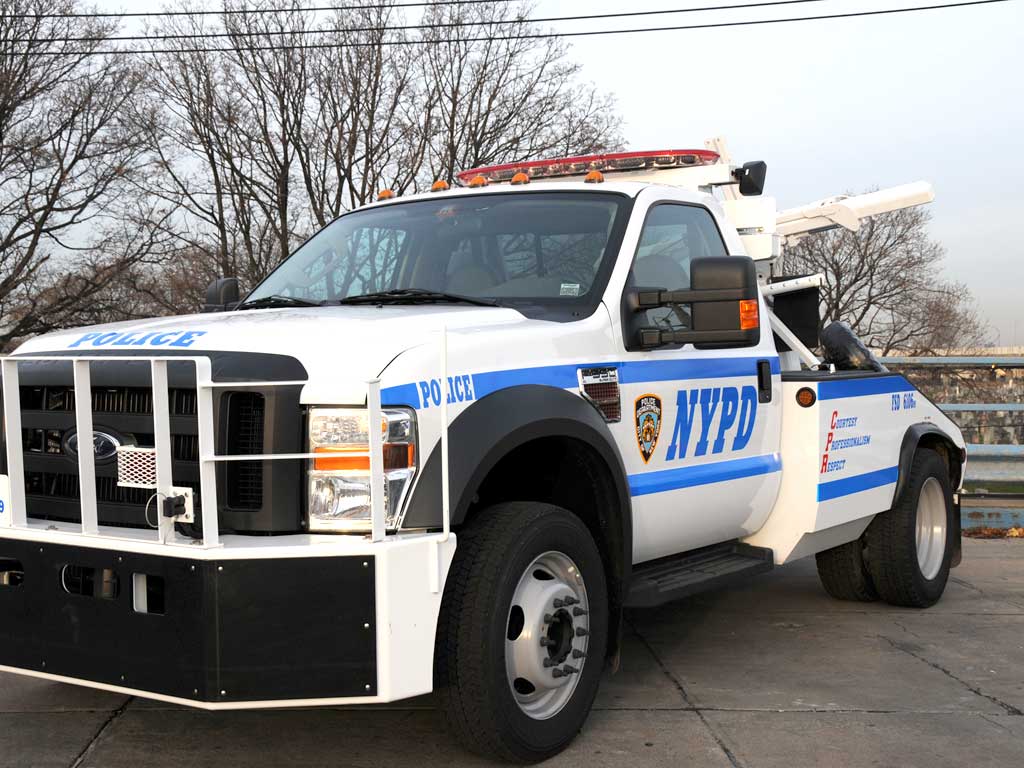
Operations: Snowstorm Tow Truck Task Force
To move the record number of disabled and abandoned vehicles on city streets after the December 2010 snowstorm and make way for the City's plows and emergency response vehicles, OEM, the Fire, Police, and Sanitation Departments established a Tow Truck Task Force. This task force coordinates the City’s deployment of tow trucks and snow or debris removal equipment to maximize these resources. The Tow Truck Task Force was also used following Hurricane Irene and the October 2011 winter storm.
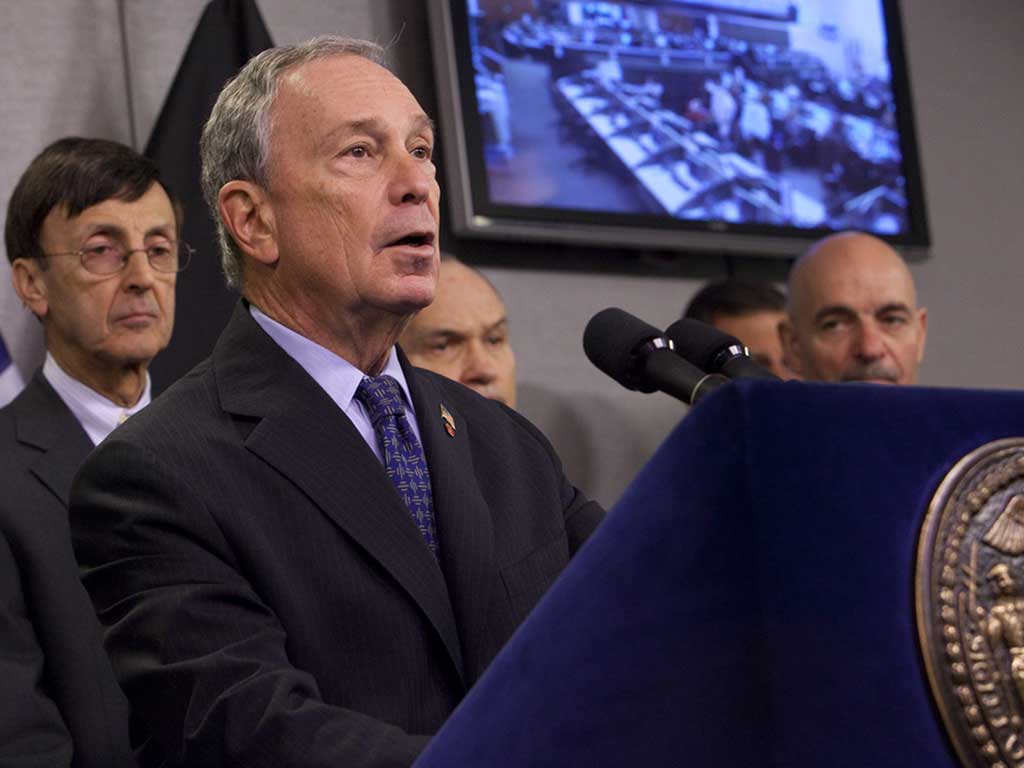
Operations: Snowstorm Hazardous Travel Advisory
After the December 2010 snowstorm, the City amended the process for declaring emergencies and introduced a Hazardous Travel Advisory to caution residents against unnecessary driving during a snowstorm and keep roads clear for plows and emergency vehicles. OEM created the Snow Operations Playbook to guide agency decision-makers through the activation and use of new winter weather declarations and protocols.
Photo Credit: Spencer T. Tucker
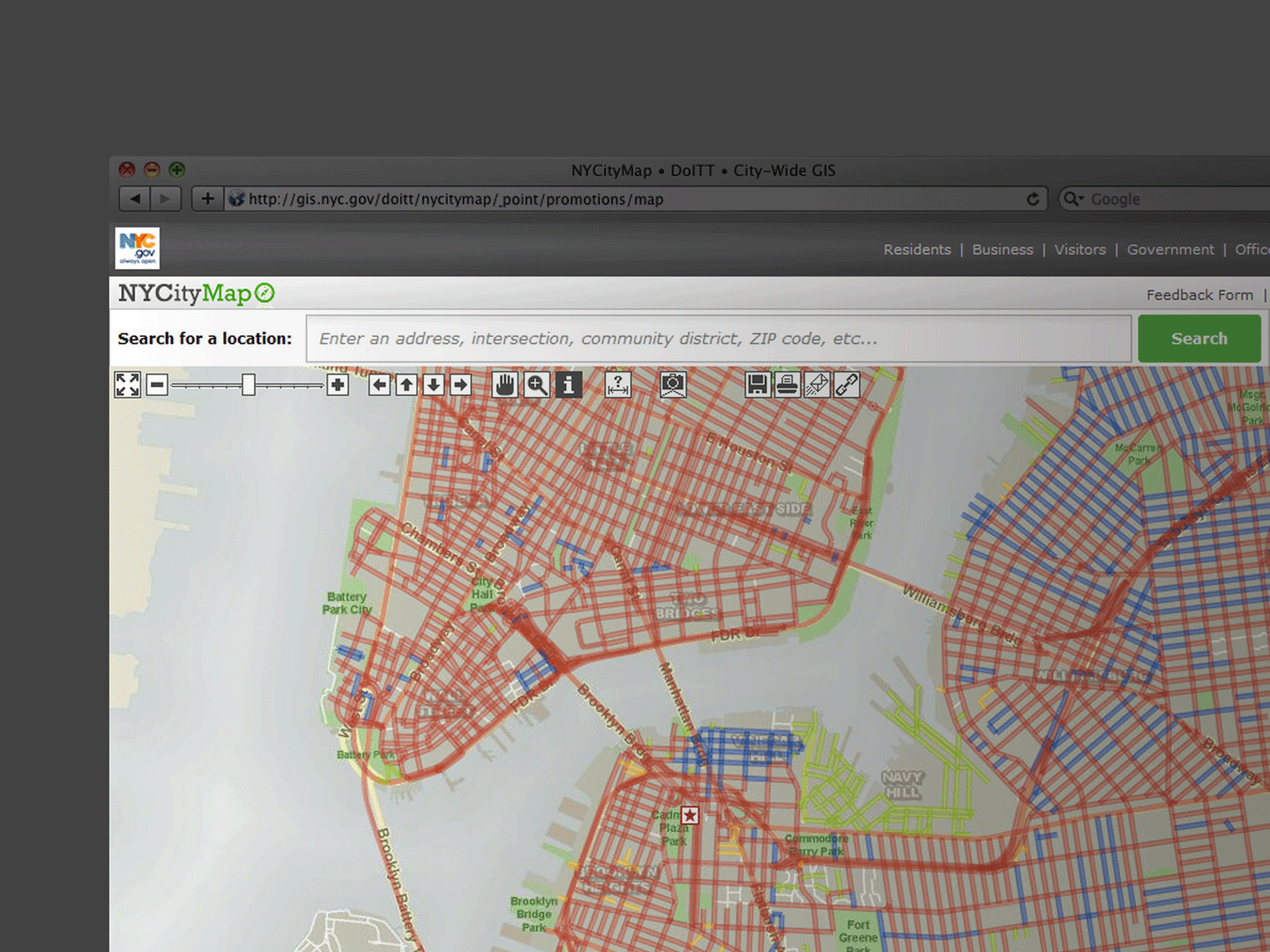
Operations: Snow Removal Routes
OEM's GIS unit worked with the Sanitation Department to create maps of primary, secondary, and tertiary snow routes to track snow removal operations and help New Yorkers determine how quickly their streets will be plowed.
The snow removal designation map can be accessed on the City's Severe Weather site or via the NYCity Map.
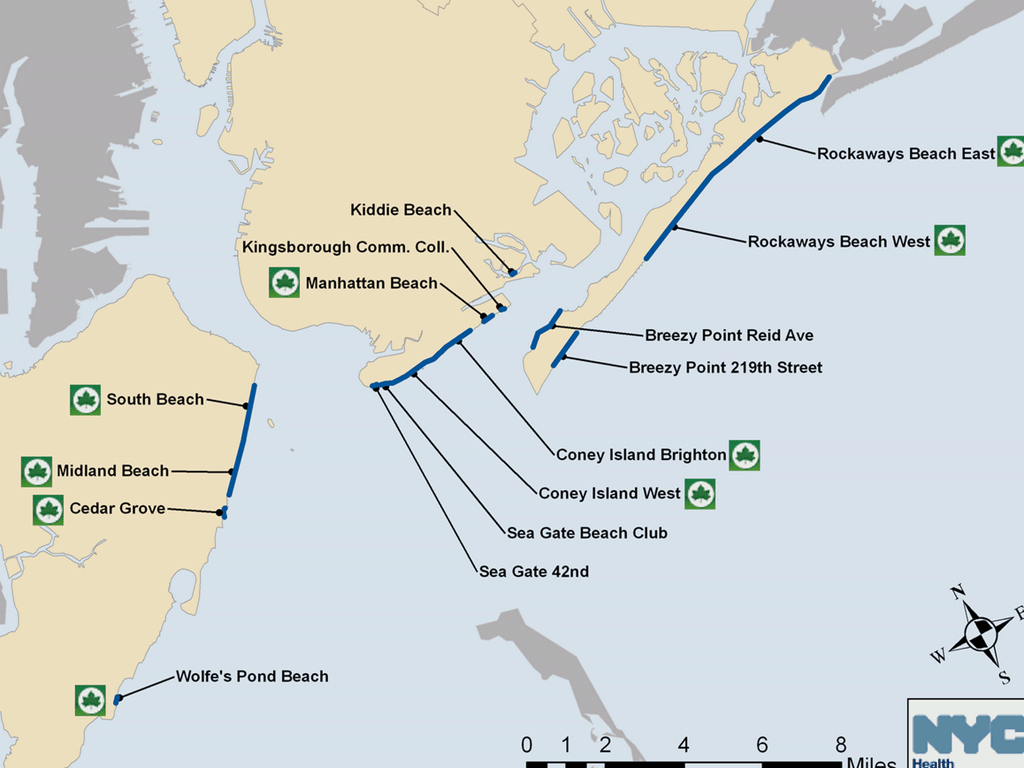
Operations: Sewage Treatment Plant Fire
On July 20, 2011, a four-alarm fire swept through the North River Wastewater Treatment Plant. The plant, which treats 120 million gallons of wastewater a day, had to be temporarily shut down and wastewater was discharged directly into the Hudson River. While the Fire Department suppressed the fire, OEM and the Department of Environmental Protection alerted the public about the hazard. Several city beaches were closed due to the wastewater discharge.
Sewage Treatment Plant Fire
Following the July 2011 sewage treatment plant fire, several city beaches were closed as untreated sewage flowed into the Hudson River.
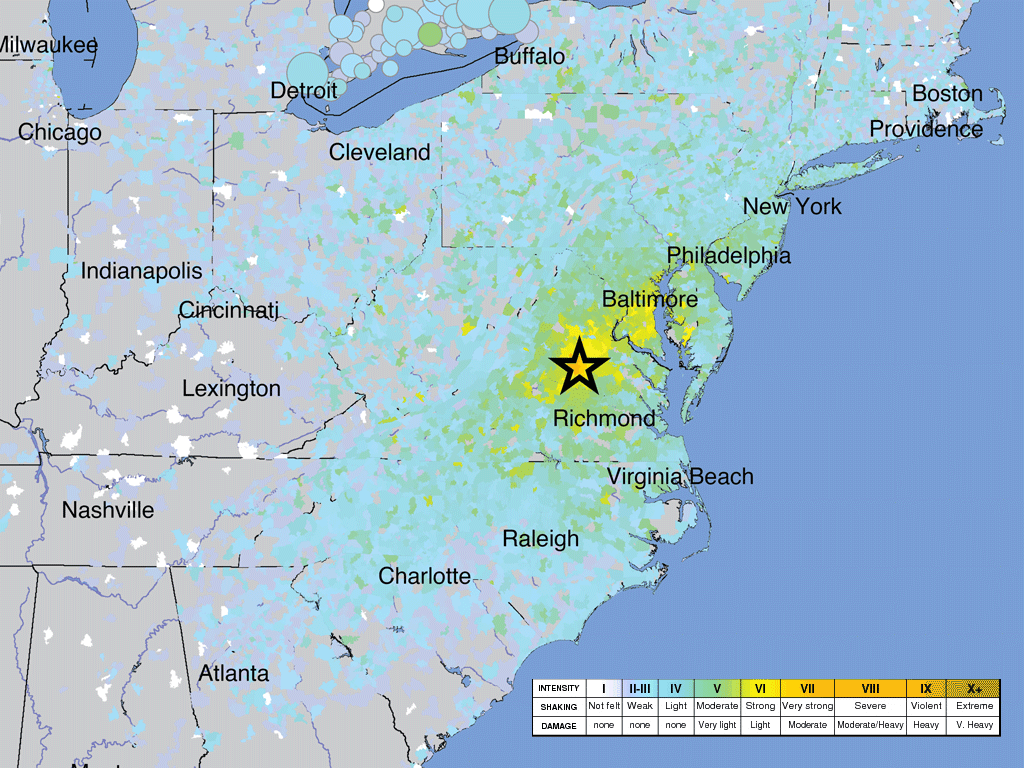
Operations: Virginia Earthquake
On August 23, 2011, New Yorkers felt tremors from a 5.8 magnitude earthquake centered in Louisa County, Virginia. The quake was the largest to affect the U.S. east of the Rocky Mountains since a 5.8 magnitude earthquake on the New York-Ontario border in 1944. Following the earthquake, OEM began including more robust earthquake safety information in Ready New York preparedness presentations and created the Ready New York Earthquake Safety Guide.
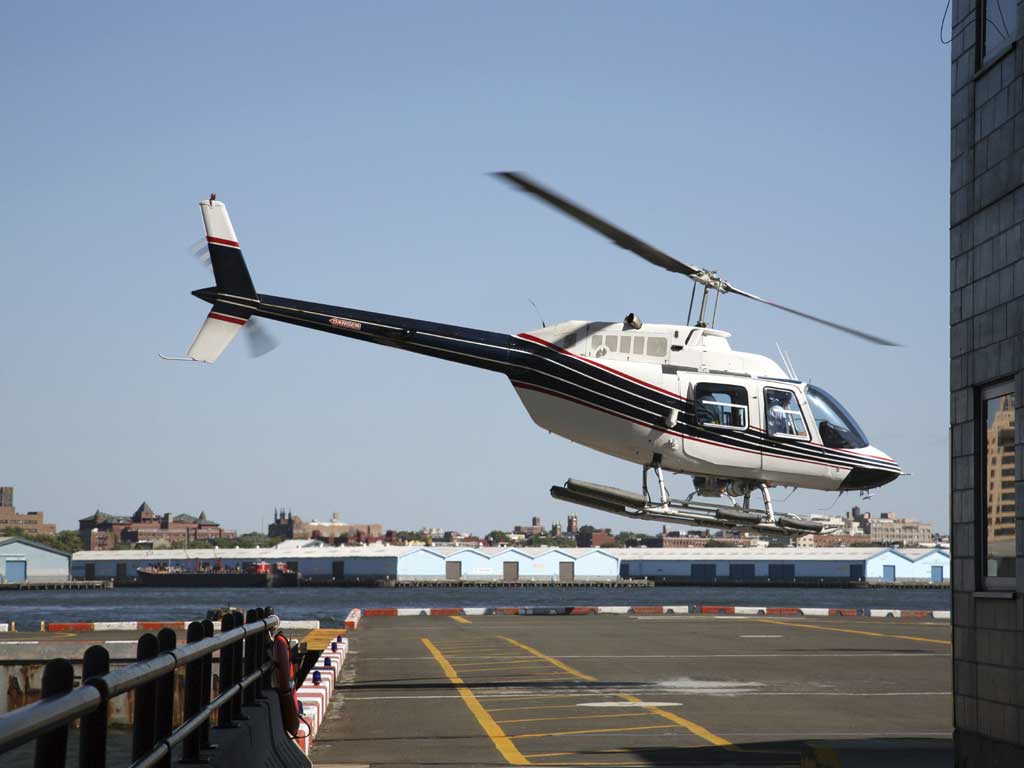
Operations: Helicopter Crash in the East River
On October 4, 2011, OEM responders were first at the scene of a helicopter crash in the East River. They pulled survivors out of the water and administered first aid. Following the initial response, OEM transported the helicopter to Floyd Bennett Field and escorted the National Transportation Safety Board response team through its investigation of the accident.
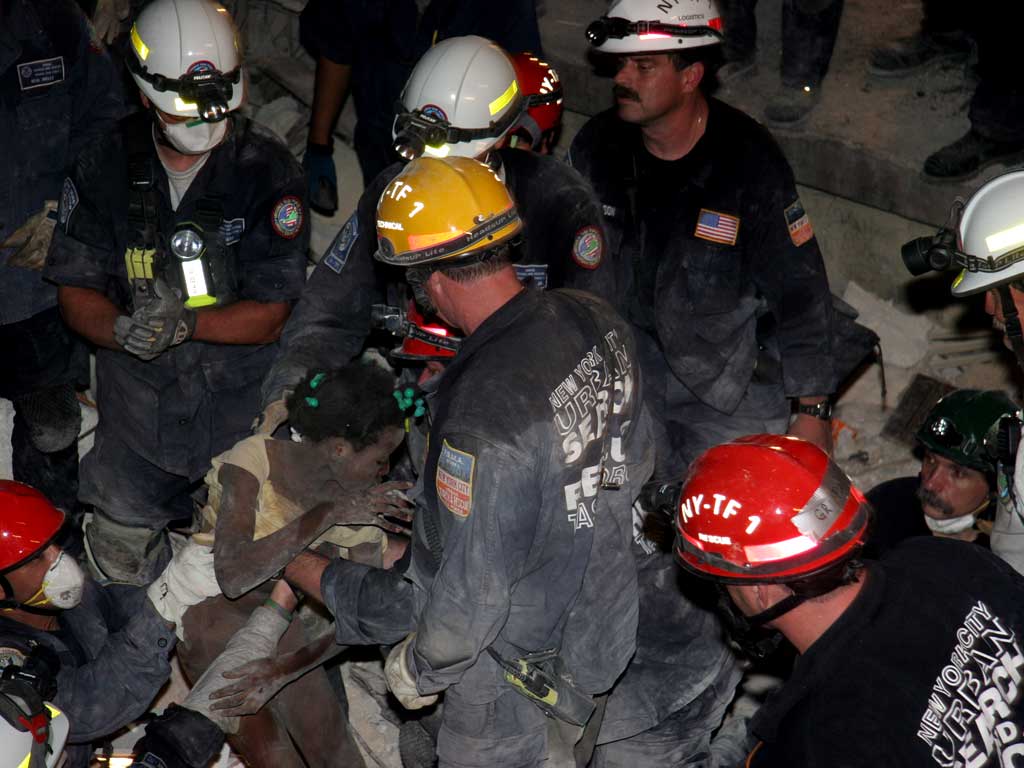
US&R: Haiti Deployment
In January 2010, 80 members of New York's Urban Search and Rescue Team, New York Task Force 1—funded by the Federal Emergency Management Agency (FEMA) and managed by OEM— loaded 20 tons of equipment into a military transport plane and flew to Haiti to assist with rescue operations in the aftermath of the devastating earthquake in Port-au-Prince. The team rescued six people, including an eight-year-old boy and a 10-year-old girl, who were buried in rubble for a week. The team was a part of an international force of more than 1,700 first responders who traveled to Haiti to help. Together they rescued 132 individuals from collapsed buildings.
Urban Search and Rescue
Eight days after the Haiti earthquake, as the New York Task Force 1 US&R team was wrapping up work for the day, someone flagged down some team members to help free children trapped in a pile of rubble. When the team arrived at the site, they met the children's father, who had been trying to dig through the rubble with hand tools and had managed to feed a hose down to his children so they could get water. Within 45 minutes, the US&R team rescued the two children - an eight-year-old boy and his 10-year-old sister (pictured here).
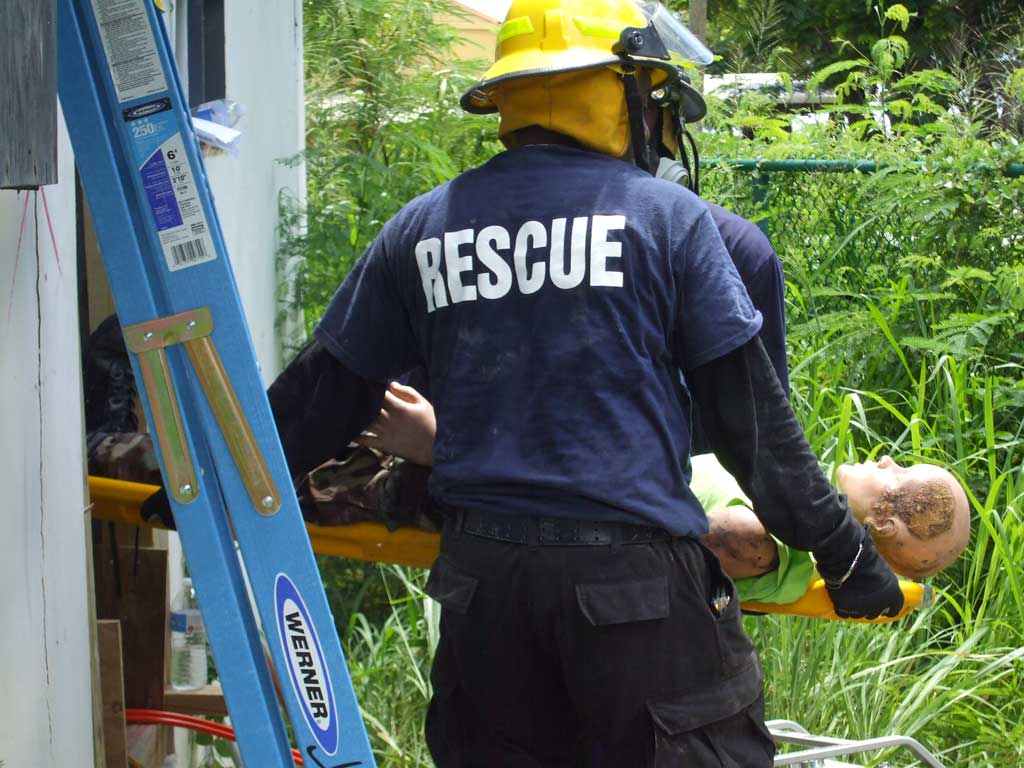
US&R: Virgin Islands Training
In September 2011, five members of New York’s Urban Search and Rescue team, New York Task Force 1, traveled to the U.S. Virgin Islands at FEMA’s request to teach 35 members of the Virgin Islands Fire Department and Volunteer Rescue Department about responding to structural collapse emergencies. During the four-day class, participants learned about different structural collapse scenarios, how to shore a collapsed building to make it safe for first responders, and how to safely extract victims.

Commemorating the 10th Anniversary of September 11th
Throughout 2011, various community groups and organizations invited Commissioner Bruno and other members of OEM's executive staff to speak about how OEM has changed in the 10 years since the September 11th attacks. Following the official ceremony at Ground Zero to mark the 10th anniversary of the attacks, over 300 current and former OEM employees reunited at OEM headquarters for a special open house commemoration.

Collect and
Disseminate
Information

Continuity of Operations Planning Program (COOP)
COOP works to ensure all City agencies can continue to provide essential public services in the event of an emergency that disrupts government operations. The OEM COOP team worked with all 41 agencies to build their plans for 170 essential functions. To test those plans, OEM coordinates an annual three-part exercise series that consists of agency tabletops, a notification exercise, and an executive-level interagency workshop to discuss larger policy issues. COOP plans have also been used during incidents such as Hurricane Irene and snowstorms.
Continuity of Operations
Commissioner Bruno joined DCAS Commissioner Edna Wells Handy, DoITT First Deputy Commissioner James Fowler, Law Department Managing Attorney G. Foster Mills, Office of Payroll Administration Executive Director Robert Townsend, Office of Labor Relations Commissioner James Hanley, and OEM Deputy Commissioners Jake Cooper and Rachel Stein Dickinson for a panel discussion at the 2011 Executive COOP Workshop. Held on November 17 at Baruch College, the workshop focused on the City's ability to continue delivering essential services to the public during emergencies.
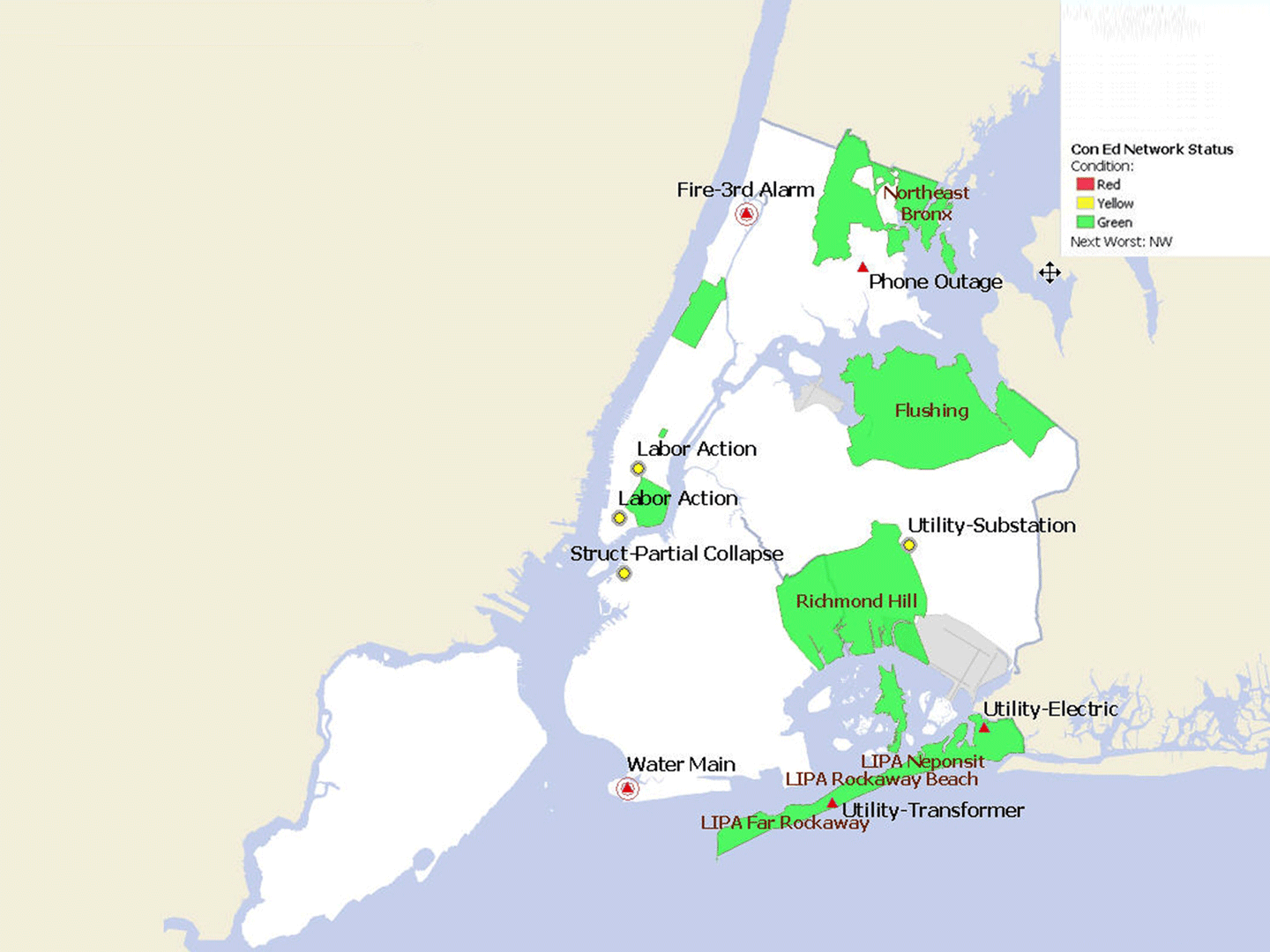
Geographic Information Systems
Working closely with OEM's Operations staff, the GIS division developed two award-winning applications: the Active Incident Dashboard and the Emergency Response Data Packet System. The Active Incident Dashboard displays all emergency incidents being actively monitored by OEM on a map. The Emergency Response Data Packet System enables OEM responders to retrieve maps and reports about an incident scene, including data on administrative boundaries, nearest critical facilities, demographics, and land use. These applications won the Urban and Regional Information Systems Association's 2010 Exemplary Systems in Government Award and an NYC Excellence in Technology Award in 2010.
Geographic Information Systems
A snapshot of OEM's Active Incident Dashboard shows a range of emergencies the agency monitored simultaneously, including a water main break, a third-alarm fire, and multiple power and phone disruptions. The dashboard is designed to be displayed on large screens in the Emergency Operations Center and in OEM's Watch Command.
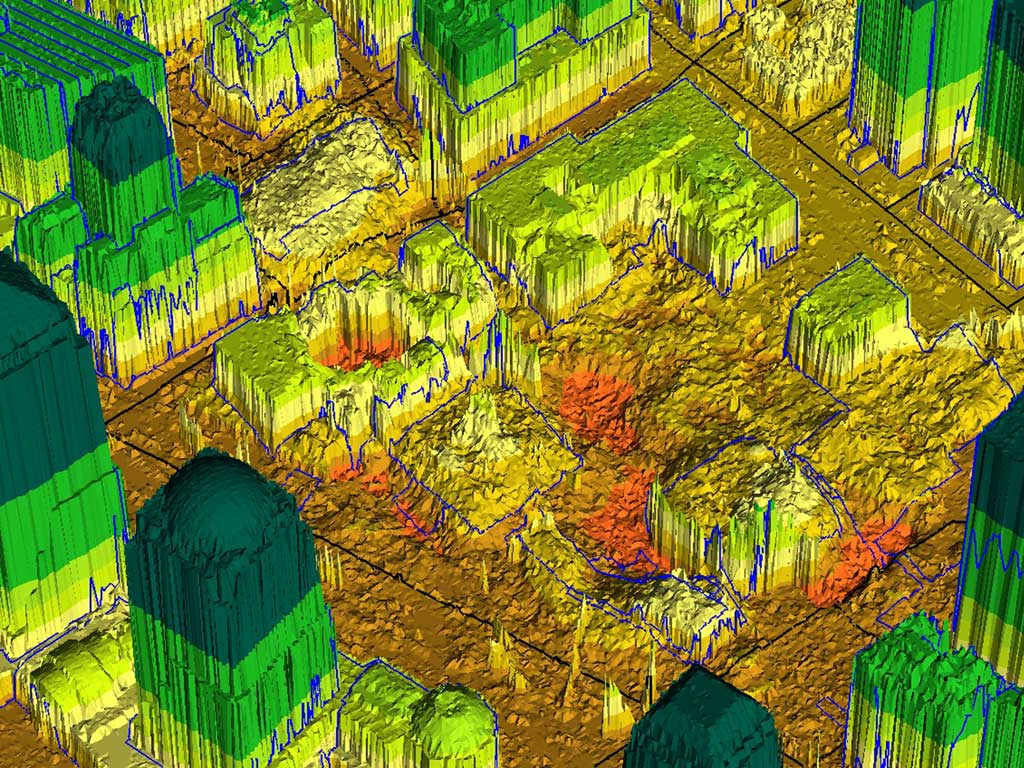
NYC GeoSymposium
On November 16, 2011, OEM and the Department of Information Technology and Telecommunications hosted NYC GeoSymposium: 2001-2011-2021, which featured a keynote address by master information designer Edward Tufte. The GeoSymposium explored how NYC's geospatial resources were used in the wake of the September 11th attacks, in the 10 years that followed, and how they may be used in the future.
NYC GeoSymposium
Aerial imagery depicting detailed elevation data obtained through the use of LIDAR (light detection and ranging) technology for the World Trade Center site, September 18, 2001.

Hurricane
Irene

Pre-Storm Decision Making
On August 24, 2011, while Hurricane Irene was still off the coast of Cuba, the National Weather Service advised OEM there was a 20-30% chance that tropical storm force winds would affect New York City beginning Saturday night, August 27. OEM activated the Coastal Storm Steering Committee, which brought together 40 agencies, and held a Commissioner's Conference Call with agency heads and City Hall to alert agencies about the approaching storm and guide the group through key decisions. At 2 PM on August 24, OEM activated the City's Emergency Operations Center.
OEM worked closely with the National Weather Service to monitor the hurricane forecast. A National Weather Service meteorologist worked from the Emergency Operations Center to provide real-time information for OEM and agency representatives.
Photo Credit: Samantha Modell
Pre-Storm Decision Making
Commissioner Bruno explains the latest storm tracking projections to Mayor Bloomberg and the Coastal Storm Steering Committee in the Situation Room at OEM headquarters.
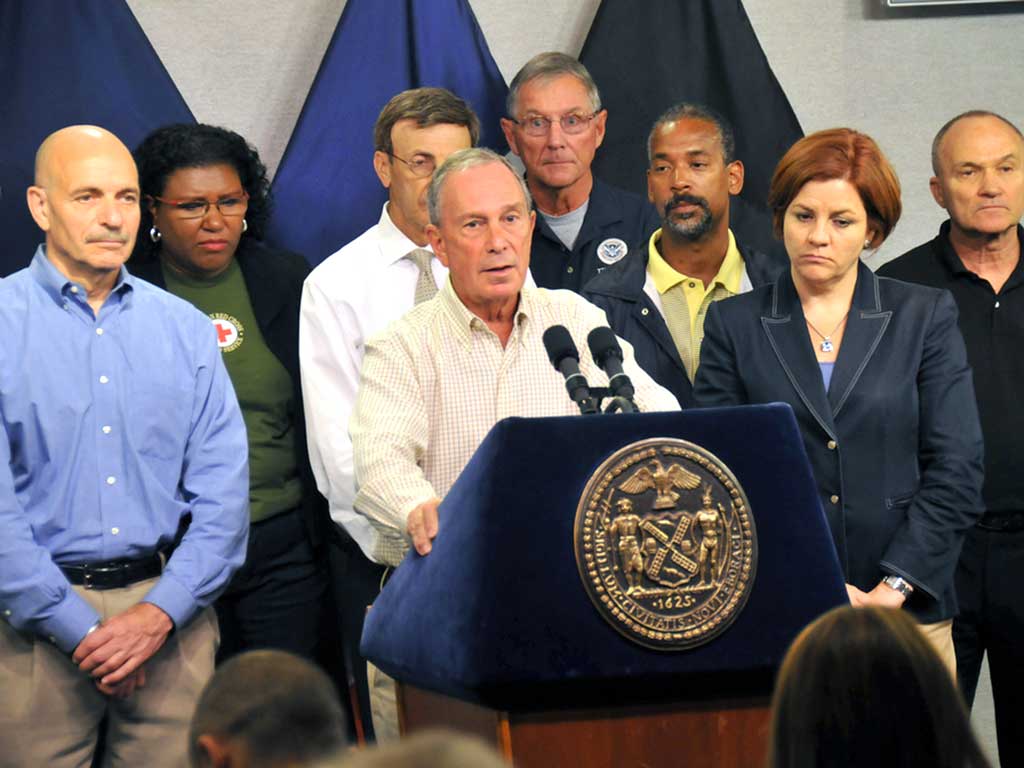
Evacuation
By the morning of August 25, National Hurricane Center predictions showed New York City directly in the path of the oncoming storm. At 6 PM that evening, Mayor Bloomberg ordered 13 healthcare facilities in hurricane Zone A to evacuate. On August 26, Mayor Bloomberg issued a mandatory evacuation order for 370,000 residents, including the entire Rockaway Peninsula and 34 healthcare facilities in Zone B. The Mayor encouraged residents to evacuate before the MTA shut down all transportation services at 12:00 PM on August 27. Post-storm polls indicate that approximately 50% of residents in Zone A and the Rockaway Peninsula evacuated.
Photo Credit: Samantha Modell
Evacuation
Mayor Bloomberg issues the first-ever mandatory evacuation of New York City's coastal areas from OEM's briefing room. The evacuation order applied to approximately 370,000 residents.
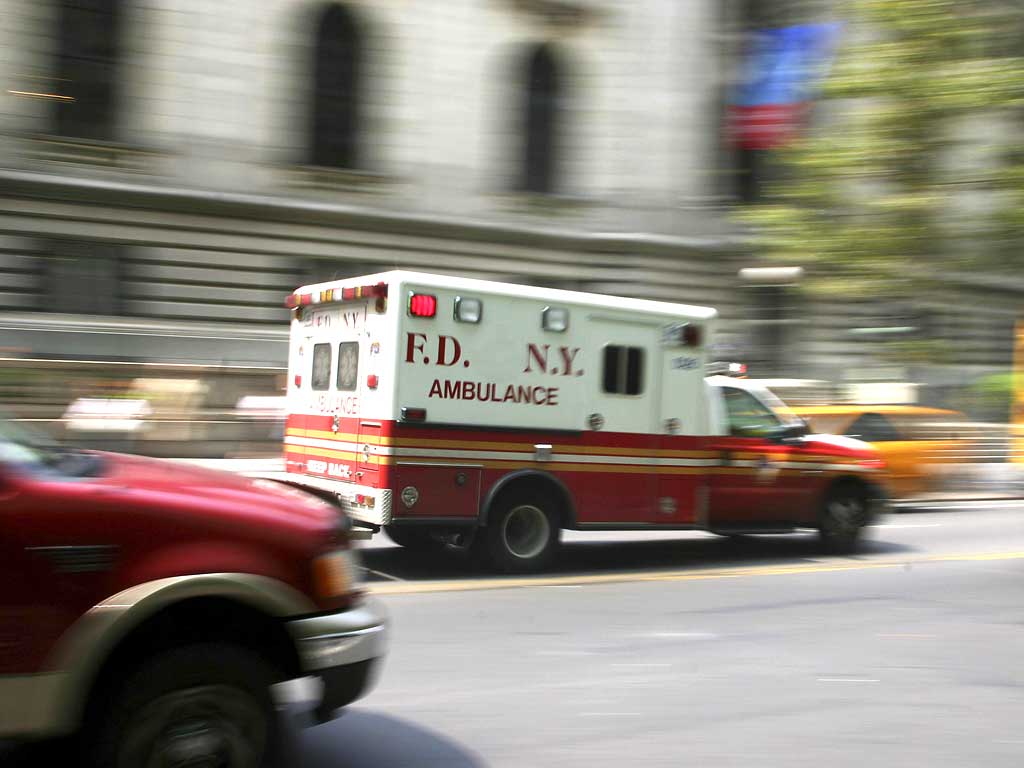
Homebound and Healthcare Facility Evacuation
Approximately 7,100 patients from 43 health care facilities including in Zone A and Rockaway were successfully evacuated before Hurricane Irene made landfall in New York City. Four additional nursing homes sheltered in place. OEM opened an interagency Healthcare Facility Evacuation Center (HEC) to coordinate evacuations. The HEC was staffed with representatives from health and medical agencies including Fire-EMS, the Health Department, New York State Department of Health, Greater New York Hospital Association, Health and Hospitals Corporation, Metropolitan Transportation Authority, and the Regional EMS Council of NYC.
Additionally, the Homebound Evacuation Operation helped evacuate approximately 200 homebound residents while the Advance Warning System effectively warned other special needs populations within the evacuation zones.
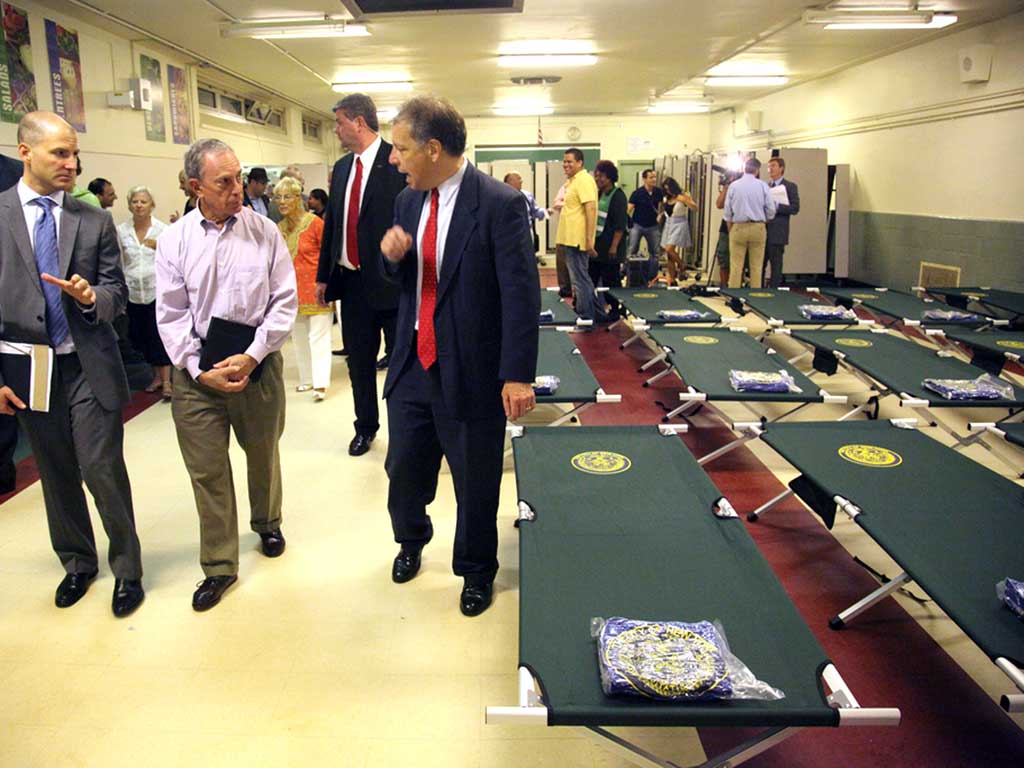
Sheltering
The City sheltered approximately 10,000 evacuees at 81 shelters, including eight special medical needs shelters. On August 24, OEM activated the Unified Operations and Resource Center (UORC) to manage the shelters, monitor facilities, and coordinate resource requests. Over 5,000 City staff, including 350 CERT volunteers and 300 Medical Reserve Corps volunteers, worked at the shelters, many for more than 36 hours.
Photo Credit: Edward Reed
Sheltering
Mayor Bloomberg tours Newcomers High School in Long Island City, Queens, one of the 81 shelters New York City opened in public schools to house residents who were evacuated from coastal areas.

Shelter Support and Logistics
On August 25, OEM activated the shelter support system consisting of the Emergency Supply Stockpile which included basic shelter supplies, such as cots, blankets, water, personal care kits, and nursing supplies. Shelter and evacuation center staff also made use of pre-positioned supplies, including shelf-stable food, administrative kits with signage and basic shelter set-up materials, and Coastal Storm Plan operator packages with field guides, maps, and shelter manager instructions. Over 3,900 pallets of critical emergency supplies and 250 pallets of Meals-Ready-To-Eat were delivered to shelters. OEM also activated the City's Logistics Center to coordinate the deployment of shelter supplies and fulfill resource requests from partner agencies, including transportation, fuel, generators, sand bags, additional cots, and support personnel.
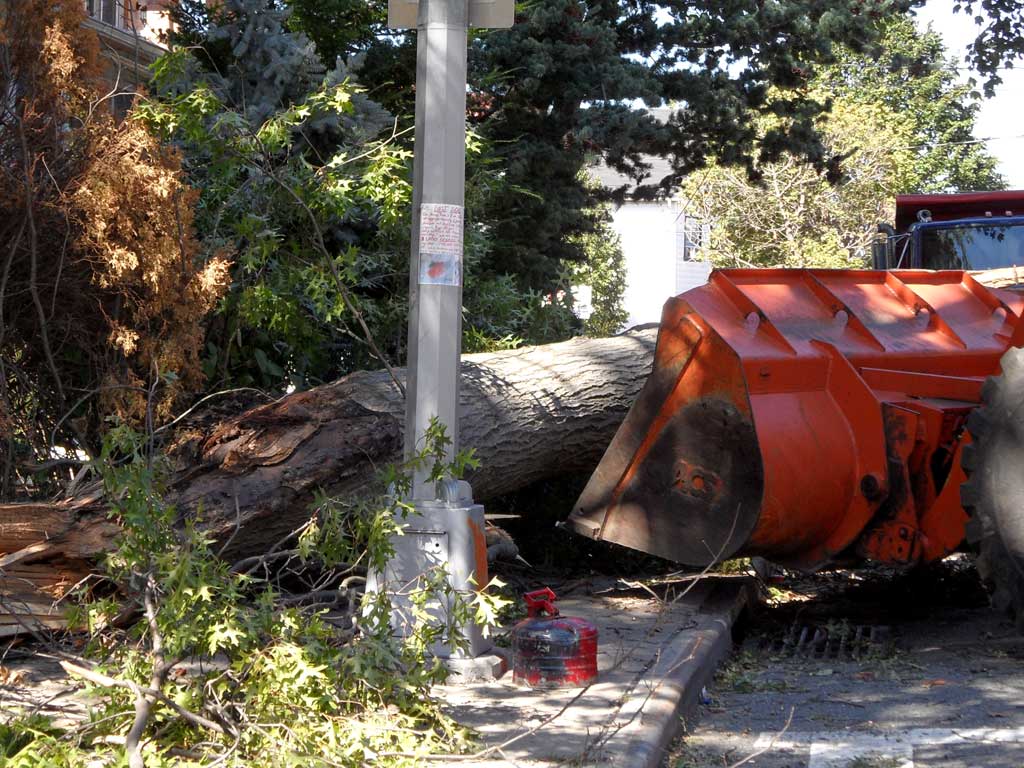
Debris Removal
A task force composed of representatives from OEM, Sanitation, Fire, Police, and Parks Departments, and Con Edison cleared the debris from the city after Hurricane Irene. The City removed almost 3,500 fallen trees and 5,000 hanging and fallen limbs in the weeks following Irene.
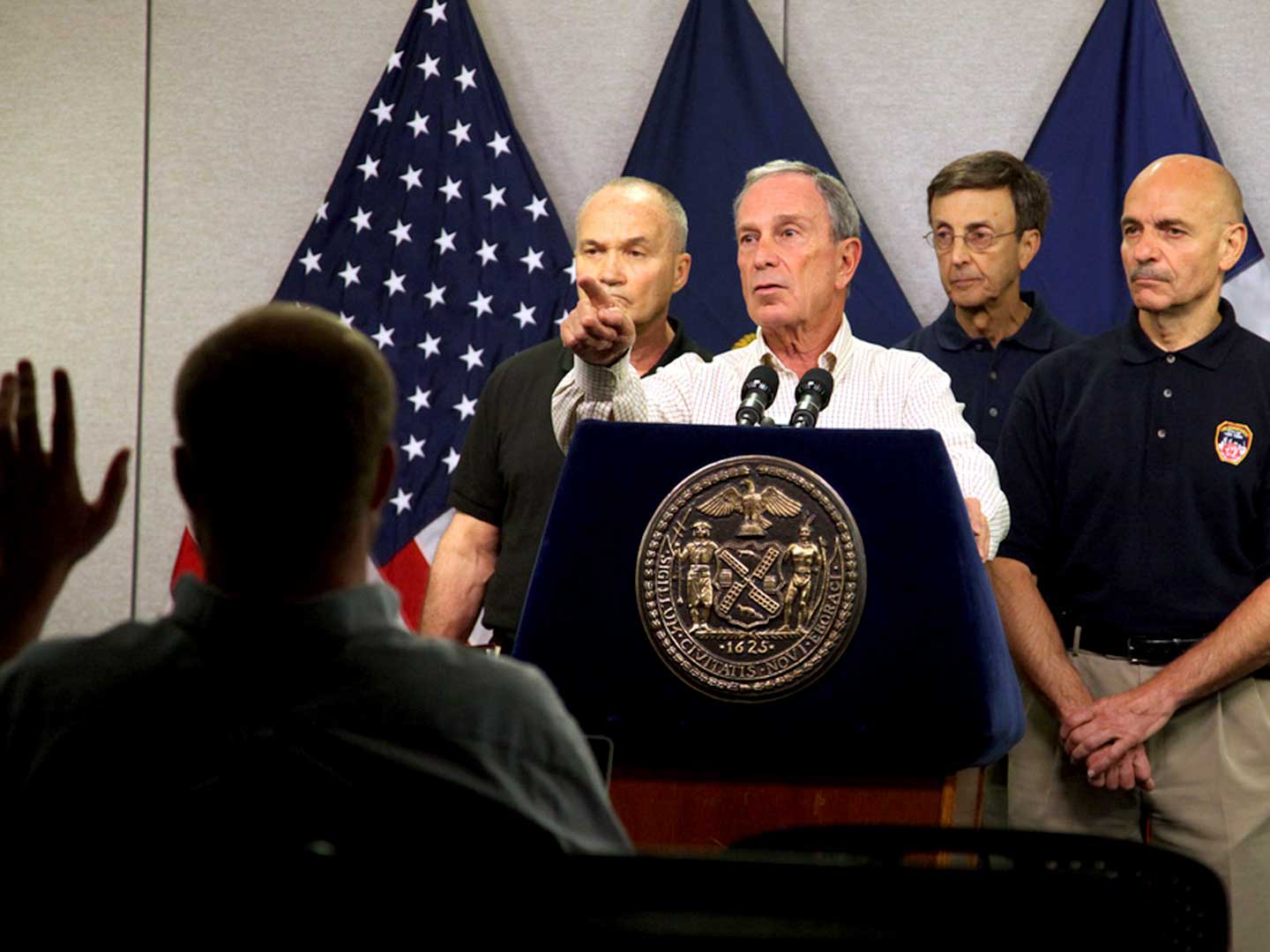
Public Messaging
The City opened a Joint Information Center located at OEM headquarters, where agency press officers and City Hall's press office coordinated a unified City message. Additionally, OEM coordinated public messaging through many outlets, including the OEM website, Notify NYC, and the agency's Facebook, and Twitter accounts. A series of press conferences with the Mayor and City officials kept New Yorkers up-to-date on the storm’s path and intensity. The City’s message to New Yorkers was strong and firm as Mayor Bloomberg ordered a mandatory evacuation for Zone A and the Rockaways, alerted residents to a shutdown of mass transit, and provided New Yorkers with important information about preparing for the storm.
Photo Credit: Edward Reed
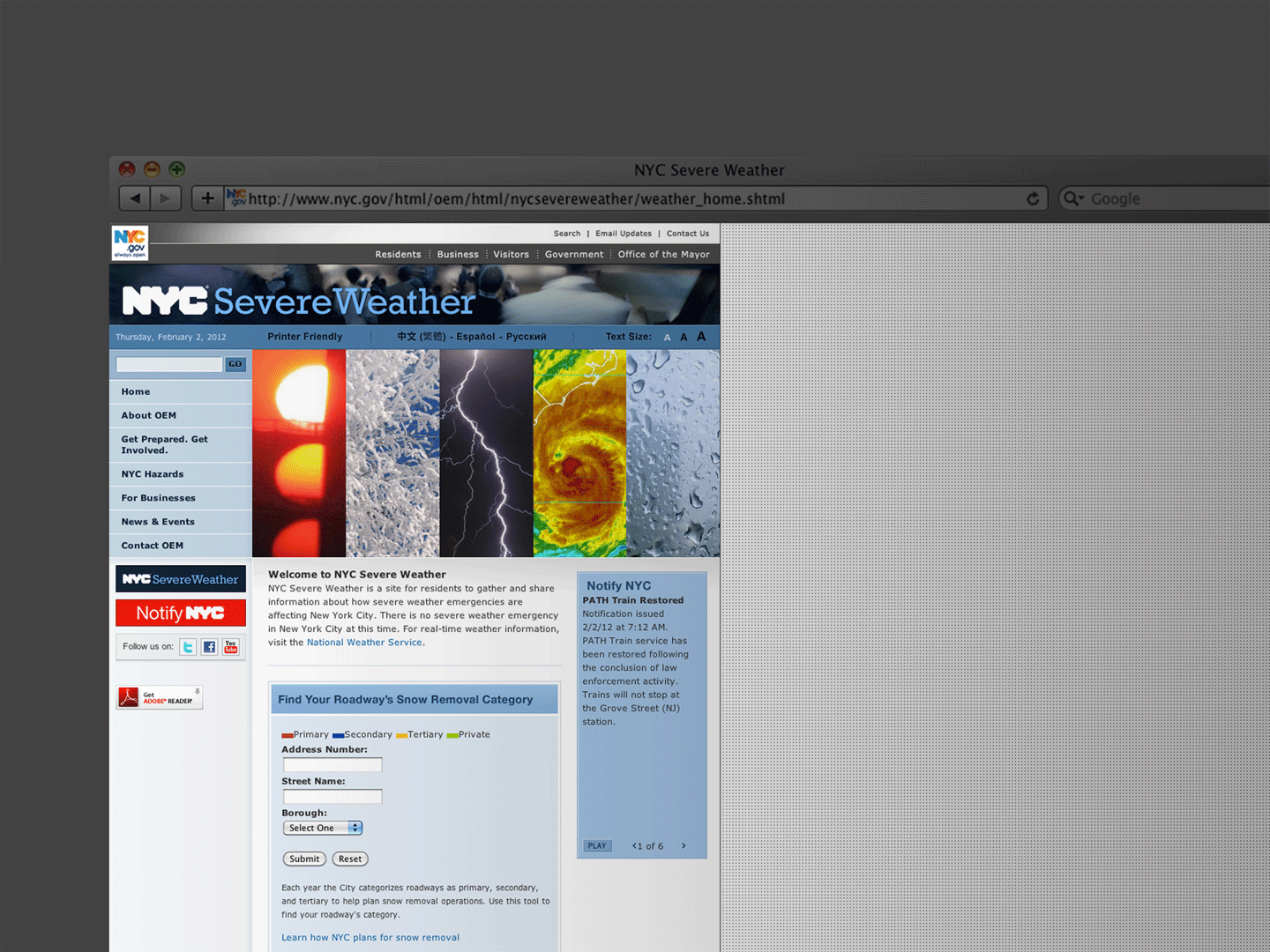
Public Messaging: Severe Weather Website & Crowdmap
In 2011, OEM launched the Severe Weather website to serve as a single location for the City to collect and disseminate weather-related information during a severe weather emergency. During Hurricane Irene, the website logged almost one million unique visitors and more than four million page views — roughly 10 times OEM's average traffic. OEM also launched a Crowdmap tool in 2011 that allows the public to submit photos and reports related to a severe weather event. The Crowdmap received over 150 submissions during Hurricane Irene that were posted to a citywide map.
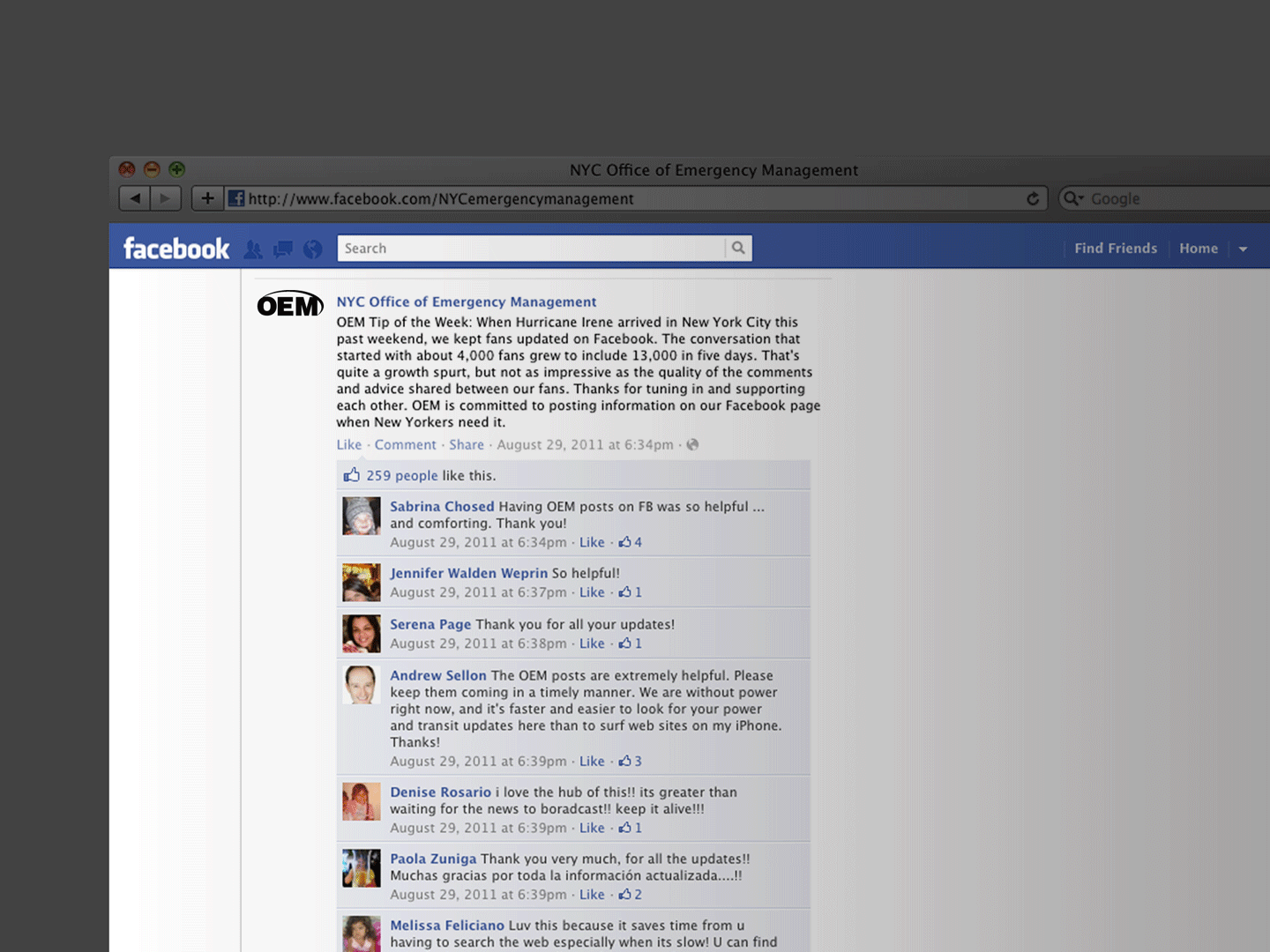
Public Messaging: Social Media
OEM posted 59 updates to its Facebook page about Hurricane Irene between August 24 and August 31. The page gained over 9,000 fans and received 804 comments during the hurricane event, and New Yorkers used it as a platform to share information with each other as well as the City.
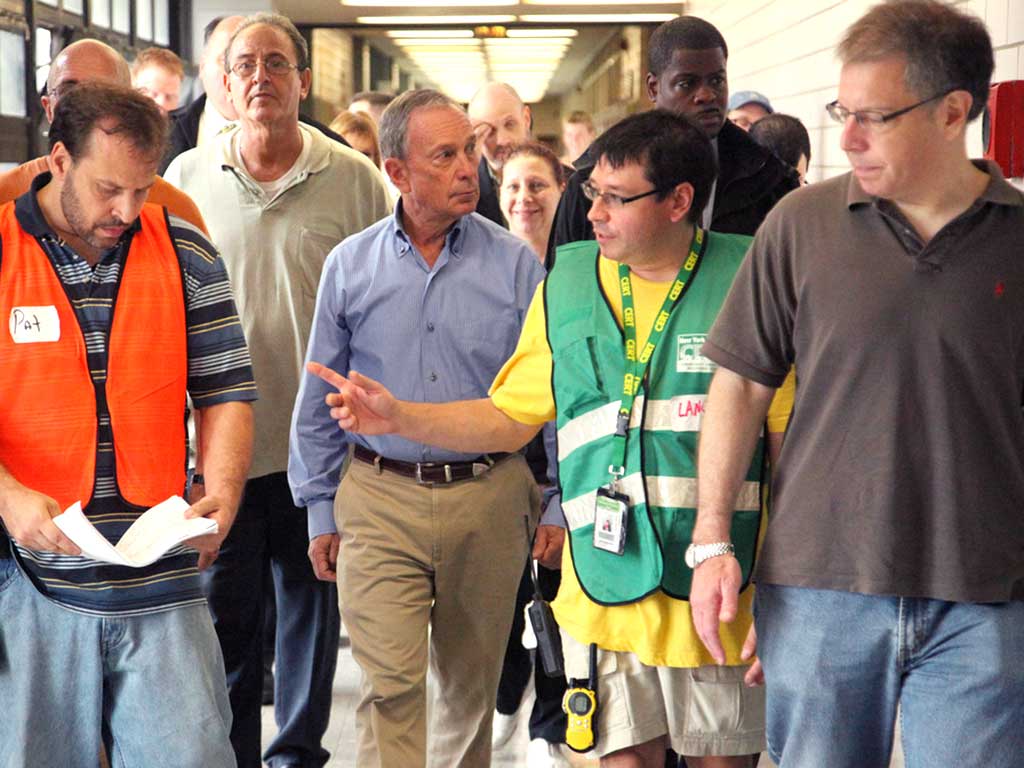
CERT
Approximately 350 CERT volunteers assisted with the City's response to Hurricane Irene. CERT members supported EOC staff, helped with the Unified Operations Resources Center, and assisted with healthcare center evacuations. CERT volunteers also helped staff shelters throughout the City.
Photo Credit: Edward Reed
CERT
Mayor Bloomberg tours the FDR High School shelter, led by CERT volunteer Lance Dashefsky.
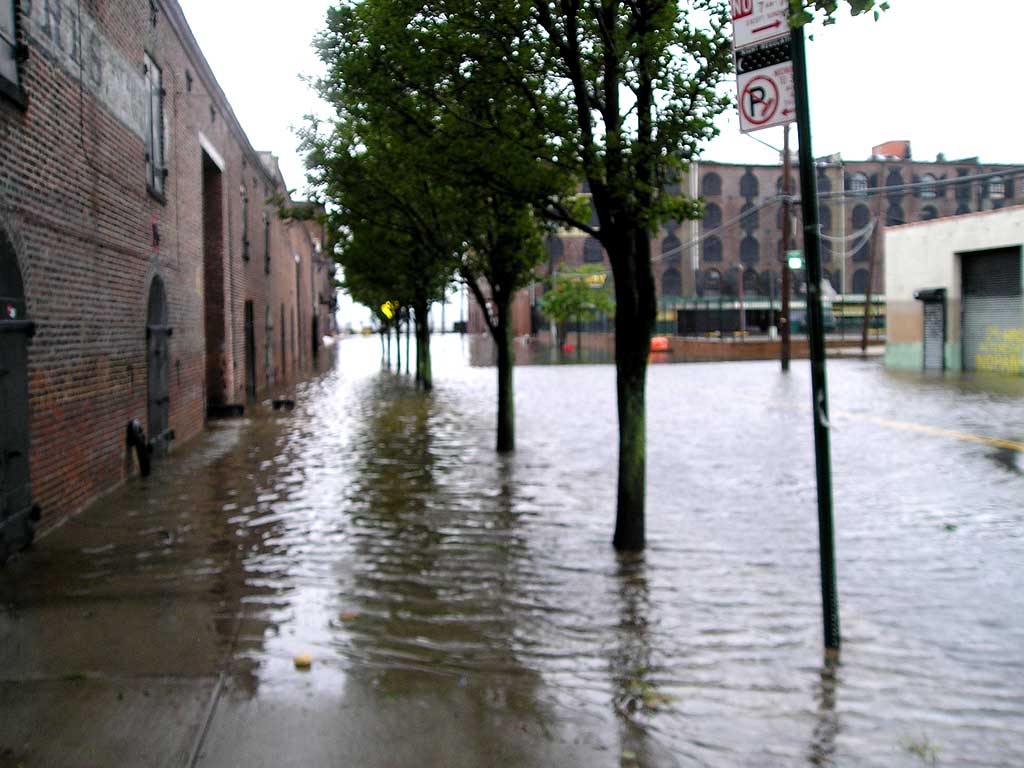
Storm Recovery
It's estimated Hurricane Irene cost the City more than $100 million. New York City applied for federal public assistance under the Stafford Act to cover costs associated with storm preparations, personnel, clean-up, debris removal, building repairs, and reconstituting the emergency stockpile.
On August 31, 2011, the federal government declared residents and business owners in Brooklyn, the Bronx, Queens, and Staten Island eligible to receive direct individual disaster aid. Over 8,000 residents in the four declared counties applied for individual assistance for storm damages. As of December 31, 2011, eligible City residents were approved for over $13.6 million in disaster assistance.
Storm Recovery
Storm surge flooding in Red Hook, Brooklyn, during Hurricane Irene.

